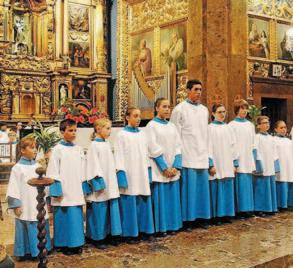A TG OXFORD ESCORTED



Original, all‐inclusive holidays providing unique insights into the areas visited. We walk – because the best way to see a country is on foot!


ATG Escorted trips, researched and developed since 1979, offer a range of high‐quality, original travel experiences that provide unique insights into the areas visited. We walk – because the best way to see a country is on foot – and also because walking, apart from maximising the experience and enjoyment of travel, is the healthiest form of exercise, ensuring that you return home feeling revitalised and refreshed.
The ATG all‐inclusive basis for Escorted trips is controversial. Criteria of ‘Quality and Value’ rather than price are not fashionable today, and make ATG trips look expensive. Offering cheaper trips would be easy –cheaper hotels and meals, excluding wines and excursions, and taking clients ‘shopping’ (the 10% commission is a large source of income for most tour operators﴿. We could... except these would not be ATG trips, and to pay ‘piecemeal’ for everything that is included would work out far more expensive!
ATG is run by a Quality Control System specially designed for the company. This analyses customer
feedback and quality on a continual basis, ensuring that every aspect of every trip is monitored daily and exceeds the high standards expected by clients. ATG never compromises on quality to sell on price. Each trip is simply the best possible, and the price of each trip directly reflects ATG’s costs. The Value is in the quality of the best possible travel experience.
ATG is the ‘original’ environmentally friendly travel company. Founded on principles of Conservation and Sustainable Development, it was the first company to win the tourism industry’s two top awards: Tourism for Tomorrow (UK﴿ and the World Legacy Award (National Geographic and Conservation International USA﴿; and also the first to have an accredited Environmental Management System. ATG is ‘carbon neutral’. The ATG (Ad Terrae Gloriam﴿ Trust carries out Sustainable Development projects in many of the areas visited.
Our holidays have in common the same high quality of itinerary, interests, accommodation, service, support and attention to detail. The detailed information in this brochure and on our website will help you determine whether our trips are right for you.
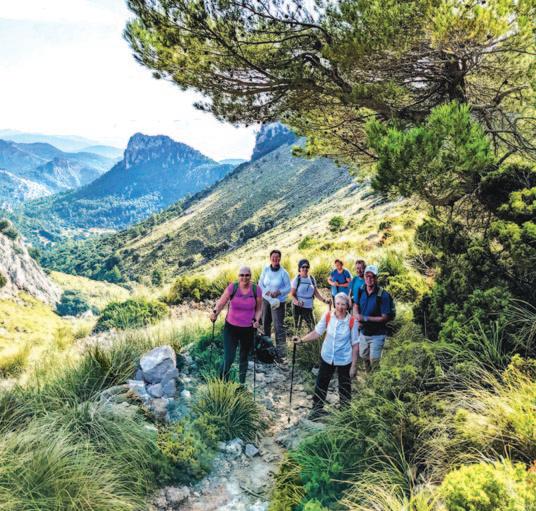








From the moment you meet our Tour Consultants to the moment you leave for home, on ATG Escorted trips everything except your own private expenditure is included.
n Trips escorted by trained ATG Leaders and Managers.
n Small, compatible groups – maximum 16 participants.
n Everything is included: all accommodation; all meals and wines; all transfers; all specified excursions and visits; and all tips en route.
n Hotels and restaurants, many of them renowned, are always the best and most characteristic available on each itinerary. Many of them have been welcoming ATG clients for decades!
n Every level of walking from easy and relaxing to challenging and momentous. Each trip has a deluxe air‐conditioned Mercedes minibus, so you can walk as much or as little as you like.
n Transport of luggage en route.
n Celebrated ATG picnics. The Tour Manager will meet you at lunchtime with an ATG picnic lunch.
n The Tour Leader will provide succinct two‐minute sound bites on each aspect of the wide range of interests in each itinerary – and if you want to know more they’ll be delighted to explore these ‘one‐to‐one’.
n Friendly and relaxed atmosphere.
n The interesting itineraries attract like‐minded people – who like each other!
n And what’s not included? Transport to/from the beginning/end of the trip, as our clients come from all over the world.
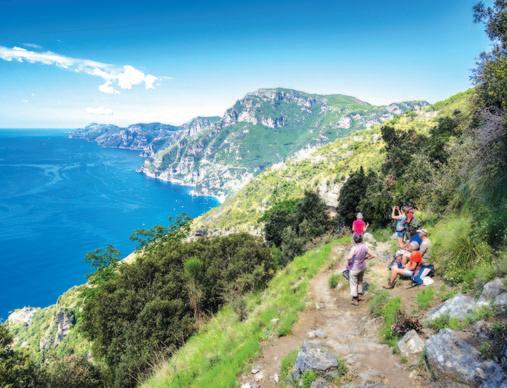

Happening upon an ATG picnic in an idyllic location punctuates each day's walk. ‘‘ ’’
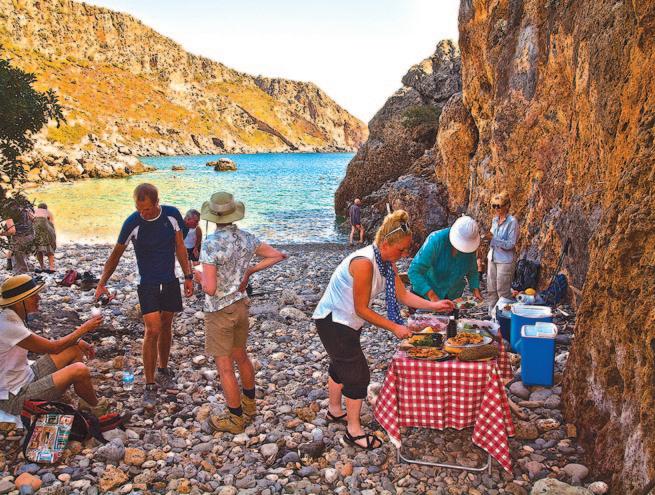
ATG picnic lunches in Europe are renowned! ‘Happening upon’ an ATG picnic in an idyllic location punctuates each day’s walk. Picnics are colourful, varied and nutritious. Buffet‐style, there is a choice of meats, cheeses, substantial salads, bread and fruit...and pudding. If it is cold there will be a hot dish. Many salads are ‘exclusive’ to ATG and some of these original recipes are in the ATG ‘Table of Moveable Feasts’ –available to buy on the website.
After being greeted with mineral water and a starter, followed by wine and an abundant lunch of local organic produce and specialities, there’s usually time for a siesta! Where there is a particularly spectacular and remote picnic spot, we may occasionally carry packed lunches.
Dinner is usually at about 8.00pm (later in Spain﴿. We tend to eat in the best and most interesting restaurants available, which serve traditional local dishes as well as regional classics and excellent regional wines.
To ensure that we enjoy the best that the area has to offer, the Tour Manager, with his/her specialist knowledge and experience, will have worked closely with the chef in advance, selecting the most interesting and characteristic menu possible.
Discovering the local cuisine is part of the adventure of travelling with ATG.
’’
This not only ensures that we eat far better than people who ‘come in off the street’, but enables us to enjoy a very wide range of local specialities during the trip, and also to cater imaginatively for those with special dietary needs.
At the start of dinner each evening, it is ATG ‘style’ to tell you about the menus and wines for that evening. If there’s anything different that you would prefer, you have only to ask.
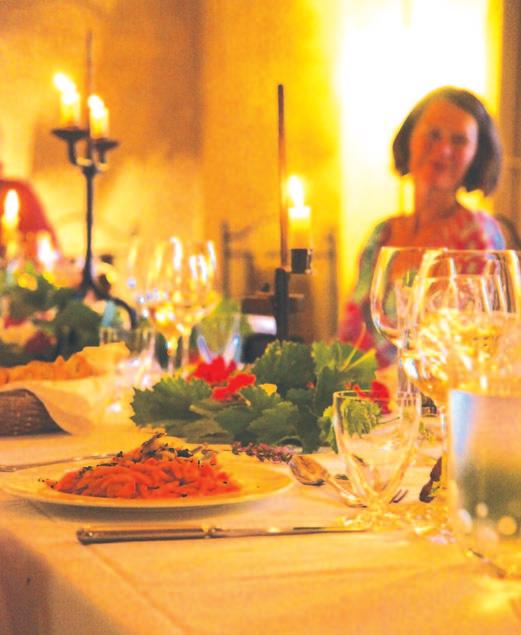
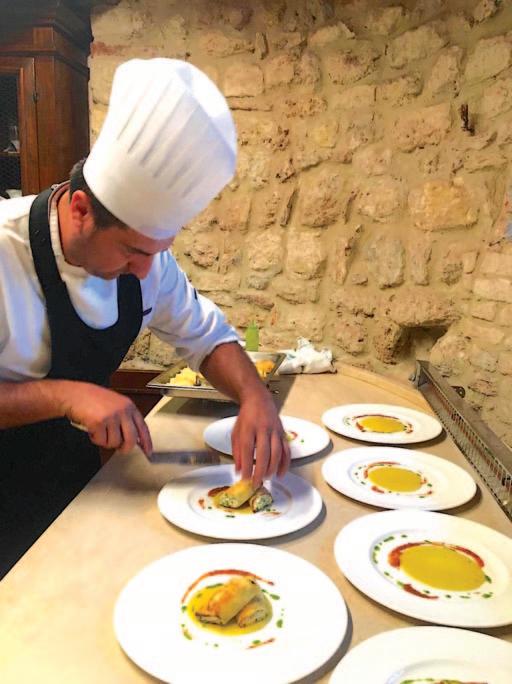
One of the greatest pleasures of travelling is enjoying a range of different regional cuisines. Part of the ATG experience is discovering the diversity of local ingredients and culinary traditions of the particular methods of cooking, and styles of restaurant.
ATG trips include a wide range of different restaurants, with some of the finest and most famous in the world. Each has been carefully selected.
Others are more traditional, providing excellent local cuisine, using recipes that have often become established ‘classics’ of regional cooking.
Which is better? It is thrilling to eat at great restaurants – each course a revelation of sensation, aroma, texture, taste, colour and decorative design, with a superb selection of wines to match.
It is also a delight to find a small restaurant specialising in authentic local cuisine using fresh, organically grown local produce, and accompanied by the best regional wines.
At ATG, whose founder/MD ‘travels to eat’ – food matters!
Whether an atmospheric palace hotel in the heart of a medieval city, or an idyllically situated mountain hotel...if that’s where you arrive in the afternoon, then that’s where you stay! ATG does not ‘bus people off’ to distant ‘standard’ hotels. You should expect successive hotels to differ in character – part of the adventure of travel.
Because groups are small (maximum 16 clients﴿ ATG is accepted by many exclusive hotels that do not usually work with travel companies.
ATG selects only the best and most characteristic hotels, conveniently situated for travellers on foot.
Accommodation ranges from 5‐star luxury hotels to converted historic monuments; characterful boutique hotels to comfortable family‐run hotels; and world‐famous city hotels.
Information
ATG provides total transparency with regard to hotels used. Publishing hotel names, locations, star ratings and pictures along with the ATG itineraries, gives them integrity. It also enables clients who require more information to check hotels online.
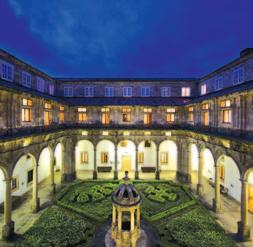
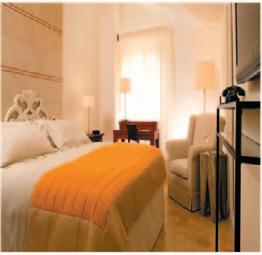
’’
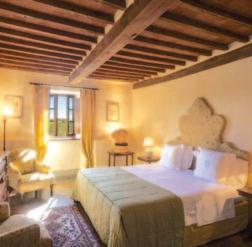
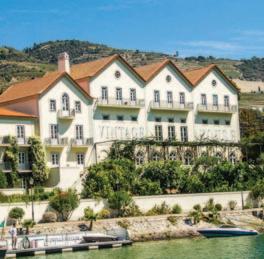

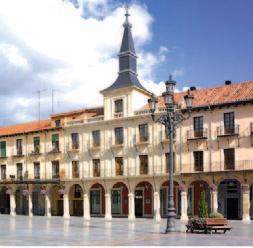
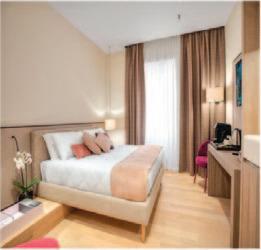
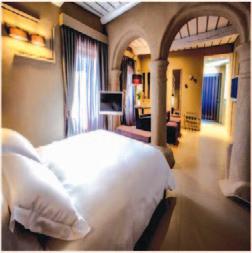




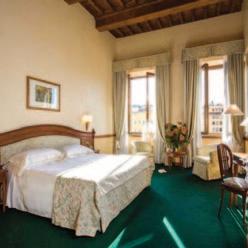
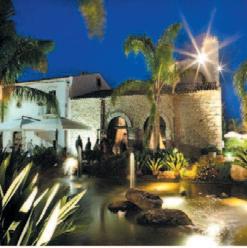
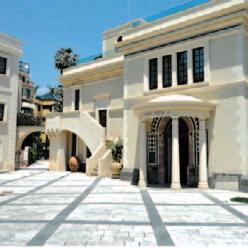
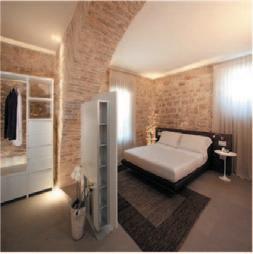
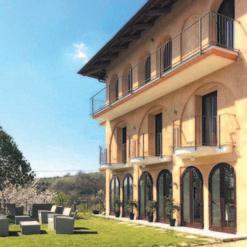
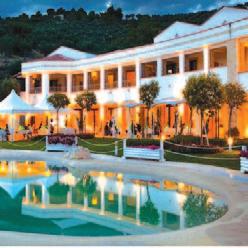

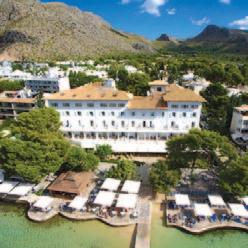


Venetian’s Venice – lunch at private palazzi on the Grand Canal, a private visit to the cathedral of San Marco in an exclusive itinerary, staying at the 5H Danieli next to Piazza San Marco.
Day 1 Note: We reserve 'classic' rooms at the Danieli. If you would like to upgrade to a 'deluxe' room with views of the lagoon, please contact the office.
From Venice Marco Polo airport a private water taxi will speed us across the Lagoon to Venice (30 mins﴿ and through a network of canals before emerging at the top of the Grand Canal – where our hotel – the 5H Hotel Danieli, is situated on the waterfront, a brief stroll from the central Piazza San Marco. There is time to explore before dinner at one of the city’s most renowned restaurants.
Day 2 We explore Venice’s tiny alleys and bridges, visit the tombs of the Doges in the church of SS. Giovanni e Paolo and the Scuola di San Giorgio degli Schiavoni, with its nine unforgettable paintings by Carpaccio. Lunch, exclusive to ATG, is at a private palazzo on the Grand Canal, offering a unique insight into the lives of Venetian aristocracy. Optional afternoon visit to the Accademia. In the evening we enjoy a private guided visit to St Mark’s Basilica, illuminated specially for us, its domes resplendent with gold mosaic.
Day 3 We visit the Doge’s Palace and Museo Correr, before meeting for lunch at another fine private palazzo on the Grand Canal. After lunch we cross the Grand Canal to the San Polo district to visit the magnificent Franciscan Church of Santa Maria Gloriosa dei Frari, and then see Tintoretto’s masterpieces at the Scuola Grande di San Rocco.
Day 4 We take a boat trip to the islands, visiting Burano, with its pastel coloured fishermen's houses, and Murano, little changed since the 15th‐century, when the glass kilns of Venice were moved there – for safety! We continue to tranquil, sparsely inhabited Torcello, once a great city; however, for greater safety and due to the threat of malaria people moved from there to the Rialto (present‐day Venice﴿. We visit the cathedral with its 9th‐century bell tower and adjacent 11th‐century polygonal church of Santa Fosca, before returning across the lagoon to Venice (1.5 miles excluding visits﴿
Day 5 Return to Venice Marco Polo airport by water taxi (30 mins﴿
u Destination airport: Venice Marco Polo
u Fitness: Grade 1
Please see important note re walking and fitness below right.*
u Days of walking: 4
u Urban walks and sightseeing
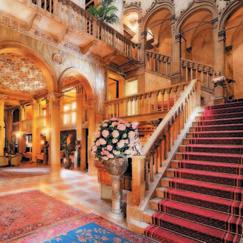
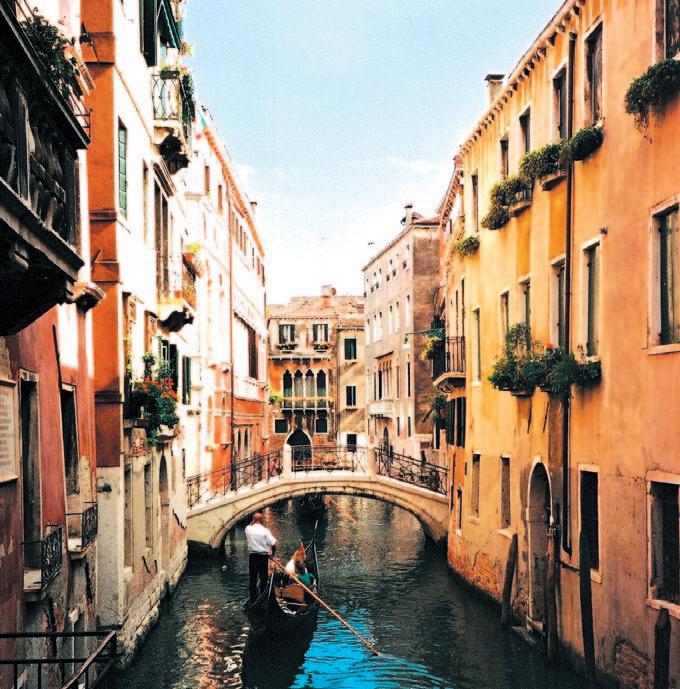
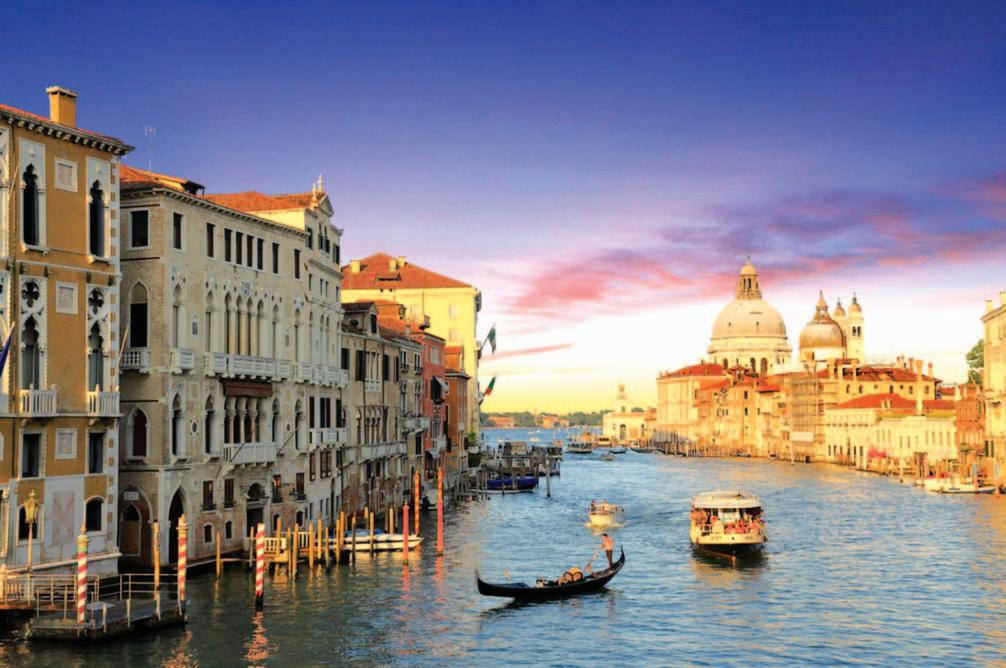
u Wonderful itinerary –a ‘Venetian’s Venice’
u Fabulous art
u Fascinating history
u Famous hotel!
Though the fitness rating for this trip is Grade 1, with walks comprising gentle sightseeing strolls, please note that there are many steps over bridges and inside buildings to negotiate. Most monuments and other buildings do not have lifts. You must be sufficiently nimble to be able to get on and off water taxis and vaporetti (water buses﴿. Please also
consider that at times of acqua alta (high water﴿, when the only way to walk about the city is on duckboards (wooden slats﴿, your walking must be stable and confident in order to enjoy the itinerary. Sturdy, comfortable footwear and warm clothing is recommended, and bring your Wellingtons just in case of acqua alta!
Wonderful fish and seafood from the Adriatic. Polenta, made from maize flour, has long been a staple of north‐east Italy, as has risotto
The wines of the Veneto are varied and include some well‐known grapes – both French and indigenous, such as Cabernet, Refosco, Raboso and Chardonnay; light, fruity reds, crisp whites and delightful sparkling wines.
Europe’s most spectacular displays of April wildflowers – with unique species. Limestone hills with panoramic sea views, fine Romanesque churches and picturesque villages.
Day 1 After arrival at Bari, we travel by road to the small city of Manfredonia (2 hours﴿, 'gateway' to the Gargano Peninsula. If flight times permit, we will pause en route to visit the interesting Romanesque churches of San Leonardo di Siponto and Santa Maria Maggiore di Siponto, whose presence allude to the enormous importance of this area at the height of medieval pilgrimage to the Holy Land.
Day 2 We drive up the great limestone escarpment behind Manfredonia into peaceful farmland and rocky meadows, where a wealth of spring flowers bloom. We wander the open hillside, typically enjoying displays of wild iris and a great variety of orchids, possibly including the rare endemic Sipontum orchid. After picnicking amongst the flowers, we complete our circular walk (3 hours + 1 hour﴿, and return to Manfredonia by road.
Day 3 We drive – up – to Monte Sant’Angelo, the highest and most historic town on the Gargano Peninsula (880m / 2,890ft﴿, with its remarkable 4th century rock church, 12th century basilica and Swabian castle. After exploring the town we walk out to picnic on a ridge with panoramic views over the coastal plain. After lunch our walk continues, descending the ridge through wonderfully flower‐filled meadows (1 hour + 2.5 hours﴿. Return to Manfredonia by road (20 mins﴿
Day 4 Our walk today follows quiet lanes and small paths through an unspoiled limestone landscape of farmland and woods in a 'hidden' valley. The flower displays are typically glorious, changing as we pass between habitats, and the verdant views and birdsong are equally delightful (3.5 hours + 1.5 hours﴿. Free afternoon with optional late‐afternoon excursion (by minibus – 20 mins﴿ to the Madonna di Pulsano monastery.
Day 5 We drive down towards the olive‐covered plain of Mattinata, pausing en route to visit the ancient necropolis of Monte Saraceno (1 hour﴿ Driving on, we follow small roads inland to Monte Sacro. From here, we walk up through flowery limestone rockeries and through shady woods to discover a ruined 12th‐century monastery on the summit of the 'monte', redescending to picnic in the meadows below (2 hours﴿ After lunch, we continue by road to the seaside town of Vieste (1.5 hours﴿
Day 6 Morning excursion by boat to explore the beautiful coastline of the Gargano (weather permitting!﴿. After returning to Vieste, we explore a nearby orchid site, and then enjoy another delightful, short ridge walk through high meadows with open views, descending towards the sea (1.5 hours﴿
u Destination airport: Bari
u Fitness: Grade 2 ‐ 3
u Days of walking: 6
u Shortest/longest walk: 1.5/5 hours
8 DAY TRIP, ITALY ACCOMMODATION

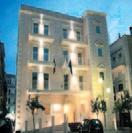
Day 7 We drive up into the hills behind Vieste. Our walk then follows small lanes and farm tracks through oak woods and pasture, with grazing Podolica cattle and free‐range pigs, along a pleasant ridge with open views, and tracks that lead us down to the olive groves behind Vieste. After picnicking in one of these, there is the option to walk on, along a quiet lane flanked by olives, to the outskirts of Vieste (3 hours + 1 hour﴿
Day 8 We return to Bari airport by road (2.5 hours﴿
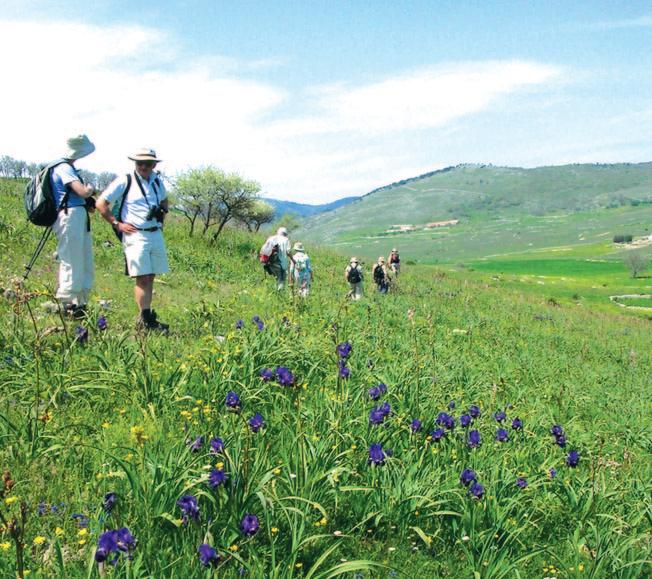
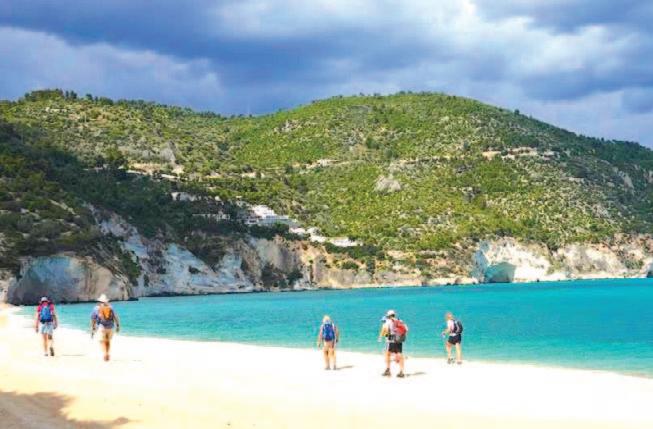
u Floral profusion with rare & unique species of orchids
u Abundant wildlife
u Historic pilgrim paths
u Inspiring sea views FEATURES
Excellent fresh seafood and roasted meats, with some interesting and original pasta dishes and dried breads. Puglia produces over 40% of Italy’s olive oil, and more than 20% of Italy's wine. The region now has over 29 DOCs – and 4 DOGCs (!﴿, making it a serious contender in the production of quality wines.
Dirt roads, woodland tracks and open country, in limestone terrain. The paths are stony and rough in places. Crossing ancient farmland we climb a number of (fairly low﴿ dry‐stone walls!

Discover ancient paths, still used by shepherds, breathtaking gorges, magnificent cave systems and remote sandy coves accessible only on foot or by sea. Wild and beautiful countryside!
Day 1 After meeting at Cagliari airport we travel northeast to our (4H﴿ country hotel, set at the edge of an extensive limestone massif, with views across a wide plateau (2 hours, 15 mins﴿
Day 2 We visit the spring of Su Gologone, near the hotel, then walk through fields and vineyards of the Oliena Valley (6 miles, 3 hours plus optional 4 miles﴿
Day 3 We climb to a volcanic plateau and follow paths through scented scrub to the prehistoric village of Serra Orrios and the 'Giant's Tomb', one of the island’s outstanding Nuraghic monuments (5 miles, 2.5 hours﴿
Day 4 We drive (20 mins﴿ to the sea at Cala Gonone, and board a boat that takes us along the coast to the sea cave of Bue Marino before continuing to the idyllic small bay of Cala Luna, fringed with pink oleander flowers. We explore the sandy river bed behind the beach then walk up to follow tracks, with wide sea views, through scented scrub … and back to Cala Gonone (5 miles, 2.5 hours﴿
Day 5 A short drive takes us to the characteristic village of Dorgali, from where we walk across open country to a dramatic underground chasm, with a stalagmite‐stalactite compound, that is the tallest in Europe and one of the tallest in the world. We then continue to a remote, sandy cove (4 miles, 2 hours﴿
Day 6 We follow a track beside the river Flumineddu, up a wooded valley to the spectacular Gola su Goroppu (gorge﴿. We enter its high, narrow, vertically sided confines, and from the dry sandy river bed, there is an optional scramble to explore further… before returning on foot (8 miles, 4 hours﴿
Day 7 We walk through forest, then follow a path past ancient juniper trees up to the remarkable nuraghic village of Tiscali, dating from the 6th century BC. We enter the cavernous interior of Tiscali mountain, an extensive open‐topped area surrounded by high cliffs, where we explore the sites of two small prehistoric villages with circular stone huts, and limestone concretions, some fused with the millennia‐old stones of the huts. After emerging into scented warmth (!﴿ we visit the sacred spring of Carros and the Oche cave (6 miles, 3.5 hours﴿
Day 8 We return to Cagliari airport (2 hours, 15 mins﴿

8 DAY TRIP, ITALY
u Destination airport: Cagliari
u Fitness: Grade 3
u Days of walking: 6
u Shortest/longest walk: 2/5 hours
ACCOMMODATION





u Orchids in the hill pastures
u Prehistoric sites in aromatic scrub
u Beaches fringed with pink oleander
u Seven nights in wonderful hotel
An original, simple and robust cuisine – lamb with mountain herbs, porceddu (whole suckling pig﴿, sheep and goats' cheese, carta di musica (paper thin sheets of crisp, unleavened bread﴿, culurgiones (pasta filled with cheese and potato﴿. Sardinia has some very good robust red wines, Cannonau and Nepente, as well as some fine whites including Malvasia, Vermentino and Vernaccia. Mirto is the local digestif that we try, made from myrtle leaves and berries.
Limestone terrain, farm and forest tracks, ancient drove tracks/roads, and coastal paths. Some stony paths.

Mysterious nuraghe:
There are more than 6,000 of these remote stone structures scattered across the island’s hills, yet little is known of their purpose or about the people who built them. There is a seemingly traditional uniformity in their construction, with large stones on the outside forming a tower, and smaller cut or trimmed ones inside forming a ‘beehive roof’ or dome, vaulted corridors and spiral stone steps to upper levels or a terrace. Structures rise to heights of 20m / 60ft, their structural strength (and potential weakness﴿ lying in the immense weight of stone.
Nuraghe have been dated to the mid‐Bronze Age – 1800‐1500BC. Architecturally they remained the most advanced in the Western Mediterranean until Etruscan times (900BC﴿
This seemingly rules out direct connection with people who built similar structures (in bagpipe playing areas!﴿ from northern Turkey to Galicia and Scotland (where the ‘brochs’ are thought to date from around 100BC﴿
Studies of the positioning of 452 nuraghe, some on earlier prehistoric sites, some of them strategic, have shown similarities in the orientation of their entrances. The most common
declinations were of around 43° for the earlier nuraghe, and 45½° for the later ones, possibly coinciding with the sunrise at winter solstice and to the moon at its southernmost rising position.
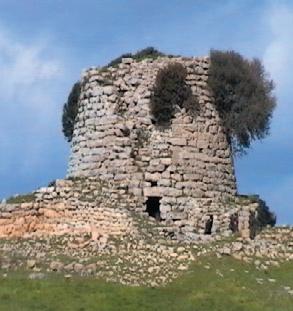
Wild! The largest – and one of the most beautiful –wilderness areas in Europe. Good paths through granite terrain, pilgrim routes and picturesque villages – then vineyards of the Douro Valley.
Day 1 After arrival at Porto airport we drive (2.5 hours﴿ to one of the most remote corners of the Peneda‐Gerês National Park and walk to our hotel in the frontier village of Castro Laboreiro.
Day 2 We walk from our hotel along a ridge with open views of the surrounding landscape and Castro Laboreiro’s medieval castle while descending into a sheltered valley with timeless hamlets. We pass through mixed woods and over medieval bridges, before ascending between massive granite boulders to our picnic lunch site (6 miles, 4.5 hours﴿. After lunch we continue on foot back to our hotel (2 miles, 1.5 hours﴿
Day 3 We drive to the renowned pilgrim village of Senhora da Peneda (30 mins﴿ and visit the sanctuary. We then climb along an ancient granite path through a wild landscape of rugged hills and granite boulders – an area rich in prehistoric monuments, rare fauna and birds (5.5 miles, 4.5 hours﴿. We then drive (2.5 hours﴿ into the Gerês National Park.
Day 4 Free day with optional walk (7.5 miles, 4.5 hours﴿ following an old Roman road in the Gerês National Park.
Day 5 We drive (2 hours﴿ to the Serra do Alvão from where we follow ancient paths, enjoying spectacular scenery and views to distant peaks, to Lamas de Olo, a medieval village of thatched granite‐block houses (8.1 miles, 4 hours﴿. A short drive then takes us down to the Douro River at Pinhão.
Day 6 After a brief transfer, we follow paths across the vine‐covered hills of the Douro Valley, with extensive views of the river, famous vineyards and quintas (wine lodges﴿, before arriving back at Pinhão for lunch (6.5 miles, 4.5 hours﴿. In the afternoon we visit a historic quinta and enjoy a tasting of some of Portugal’s most outstanding wines.
Day 7 We board a 'rabelo' (traditional boat used for transporting casks of wine down river to Porto﴿ and sail down the Douro. After lunch we complete the journey to Porto with a scenic train ride down the Douro Valley (2.5 hours﴿. In the afternoon, time permitting, we enjoy a walking tour of the city of Porto (2.5 hours﴿
Day 8 Return to Porto airport (45 mins﴿
u Destination airport: Porto
u Fitness: Grade 2 ‐ 3
u Days of walking: 5
u Shortest/longest walk: 2.5/6 hours
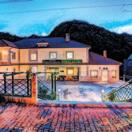


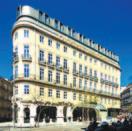

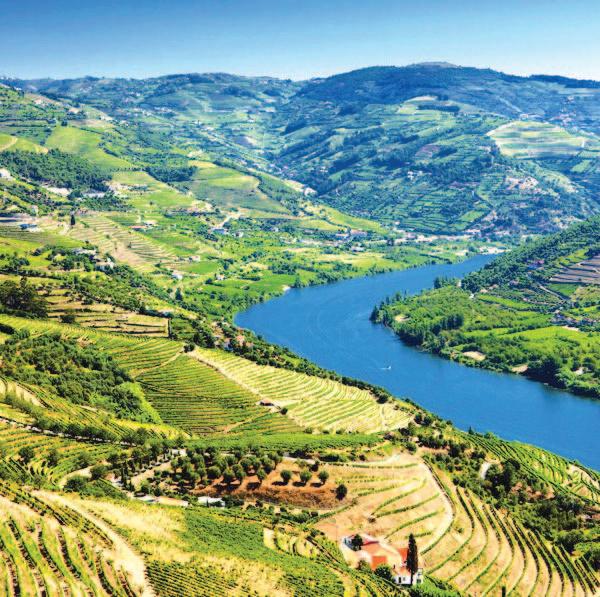
u Flowers across the Serra do Gerês
u Vineyards of the Douro Valley
u Picturesque villages
u Granite pilgrim paths
Rustic, wholesome cuisine: sumptuous stews accompanied by potatoes or rice; hearty fish and vegetable soups, often enhanced by aromatic herbs and always prepared with the best of olive oils. Fish and seafood are basic to the Portuguese cuisine and bacalhau (salted cod﴿ is still a firm favourite. The area is renowned for its interesting wines, including Vinho Verdo made from the white grapes cultivated in the vineyards of the Minho and Lower Douro Valley; and red Dão wines from the Dão Valley further south. And of course – Port!
Excellent granite paths; forest and farm tracks.

Discovering the 1st century AD Via Nova: its legacy, including 250 Roman milestones lining its route across mountains, hills and valleys into Galicia; and its rich heritage from the 10th‐century as a busy pilgrimage route to Santiago de Compostela: the Camino Real –(pr. ‘Ray‐al’﴿
Day 1 After meeting at Porto airport, we travel by road (40 mins﴿ to Braga, where we stay at a 4* hotel, a former monastery in the old city. Time to explore the oldest city in Portugal.
Day 2 We drive (30 mins﴿ to explore Citânia de Briteiros, an impressive Bronze/Iron Age site with hill fortress, and evidence also of Roman and medieval occupation. After visiting the site we walk (3 miles, 1.5 hours﴿ to lunch. We then continue by road, and walk (3 miles, 1.5 hours﴿ along a paved section of the Roman Via Nova en route towards the 12th‐century Cistercian monastery, where we spend two nights.
Day 3 After a brief transfer we walk (7.5 miles, 4.5 hours﴿ to explore the route of the Via Nova as it crosses the Terras de Bouro and enters the granite uplands. Optional afternoon walk (3 miles, 1.5 hours﴿ via water mills, pastures and woods to the Baroque Santuário de Nossa Senhora da Abadia.
Day 4 We drive (45 mins﴿ towards the Portela do Homem (750m/2,456ft﴿, the Portuguese/Spanish border, then walk (7 miles, 4 hours﴿ following the Via Nova over the border and into Spain, passing Roman milestones and picturesque cascades along the way. After lunch we visit the 7th century Visigothic church of Santa Comba de Bande; and Aquis Querquennis – a 1st century AD Roman staging post, offering lodging for travellers – with thermal baths!
We continue (40 mins﴿ by road to the delightful small town of Allariz, situated on the ancient Via de la Plata, which merges with the Nova route towards Santiago.
Day 5 We walk from Allariz, following the Via de la Plata, before continuing by road to the monastery of San Salvador de Celanova. Founded in 986, the impressive later Benedictine complex still preserves a small Mozarabic chapel of San Miguel, dating from 942. We walk from Celanova (2.5 miles, 1.5 hours﴿ to Castromao, a Celtic settlement dating from the 6th century BC, then continue by road (1 hour﴿ to Silleda.
Day 6 We visit the 18th‐century gardens of Pazo de Oca, known as the 'Galician Versailles', with their magnificent ancient camellias. We then follow the Via de la Plata from nearby Ponte Ulla towards legendary Pica Sacro (8 miles, 4 hours﴿ and spend the night at a unique winery eco‐resort in a forest setting.
Day 7 We walk from the outcrop of the Pico Sacro, following the pilgrim route (9 miles, 4.5 hours﴿ to Santiago de Compostela, and stay in the heart of the medieval city.
Day 8 Transfer (15 mins﴿ to Santiago airport. If you would like an extension booking at either end of your trip, please indicate this during the booking process and we will contact you with pricing information.
/ SPAIN
u Arrival/Departure airports: Porto/Santiago
u Fitness: Grade 2+ ‐ 3+
u Days of walking: 5
u Shortest/longest walk: 1.5/6 hours
ACCOMMODATION





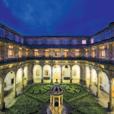

u Historic pilgrim route from Portugal to Santiago
u Roman roads & milestones
u Great landscapes, views and monasteries
u Historic hotels
Rustic, wholesome cuisine: sumptuous stews accompanied by potatoes or rice; hearty fish and vegetable soups, often enhanced by aromatic herbs and always prepared with the best of olive oils. Fish and seafood are basic to the Portuguese cuisine and bacalhau (salted cod﴿ is still a firm favourite. The area is renowned for its interesting wines, including Ribeira Sacra which is cultivated on steep terraces along the Sil River valley, and Crego e Monaguillo from Monterrei.
Roman road paths and tracks across granite landscapes.

The Roman Via or Via Nova, constructed in the 1st century AD to connect Bracara Augusta (Braga in Portugal﴿ with Asturica Augusta (Astorga in Spain﴿, has remained in an exceptional state of preservation – with 250 of its original milestones still in position. This tour explores the legacy of the Roman Via Nova, and the rich heritage of the Camino Real, its fine monasteries, its convergence with other pilgrimage routes as it nears Santiago – and much more.

Discovering easy paths through the historic heart of Catalonia – its deserted hills, Romanesque churches, exciting variety of birds and flowers, geological formations and wonderful cuisine!
Day 1 Transfer from Barcelona airport to our spectacular hotel near Peramola in the picturesque Segre Valley (2 hours﴿. Optional late afternoon walk to the nearby village of Peramola (3 miles, 1.5 hours﴿
Day 2 We follow paths behind the hotel up into the Sierra del Corb, and visit a Romanesque church with extensive views of the Segre Valley (7.5 miles, 3.5 hours﴿
Day 3 From the unusual Romanesque church at Coll de Nargó we follow an easy track through a low pass, then continue, enjoying extensive views, to the old fortified village of Montanissell (3.3 miles, 1.5 hours﴿. Optional afternoon walk – returning by a different route (4 miles, 2 hours﴿
Day 4 We travel by road (35 mins﴿ to La Seu d'Urgell to visit the fine Romanesque church, picturesque streets and colourful local market. Optional afternoon walk to a point with excellent views of the Pyrenees (5 miles, 2.5 hours﴿
Day 5 We travel by road to the picturesque Val d'Arques, and follow tracks to a fine Romanesque church (an ATG Trust restoration project﴿ Opportunities for swimming in an idyllic natural pool in the river (6.5 miles, 3 hours﴿
Day 6 We visit the spectacular Benedictine monastery of Santa Maria at Montserrat ('serrated mountain'﴿, with its black
Madonna and famous boys' choir, the oldest in Europe. Time‐permitting, optional late afternoon walk to explore the excellent walking to the west of Peramola
Day 7 We drive to Organyà and follow an ancient pilgrim path up to a remote, dramatically situated Romanesque sanctuary church with panoramic views, returning by the same route. There have been some impressive bird sightings on this walk, including two species of eagles and vultures (4 miles, 2 hours﴿
Day 8 Return by road to Barcelona airport (2 hours﴿
8 DAY TRIP, SPAIN
u Destination airport: Barcelona
u Fitness: Grade 2 ‐ 3
u Days of walking: 7
u Shortest/longest walk: 1.5/3.5 hours

Dirt roads, forest tracks and mule paths; ways across open mountains and along river banks.


u Varied landscapes with spectacular views
u 7 nights in a wonderful country hotel
u Peregrine falcons, golden eagles and griffon vultures
u Superb Romanesque churches
Catalunya boasts an excellent and varied cuisine which owes as much to its history as to the influence of the many cultures that have passed through its lands, including Greeks and Romans and more recently French and Italians. Its location in the mountains near the Mediterranean means you will find dishes that mix flavours of the ‘sea and mountain’ mar i muntanya in Catalan: combining chicken, game or beef with fish or seafood. Can Boix has a renowned restaurant where you will sample the best of what the area has to offer. Catalunya boasts numerous wines of note, including some of the most sought‐after reds in the world!

Walk through the picturesque Chianti hills from Siena, the best‐preserved great medieval city in Europe, to Florence, birthplace of the Renaissance.
Day 1 After arrival at Pisa or Florence airport we travel by road to Siena, where we stay at a hotel within the medieval city walls and walk through ancient streets to the famous central Piazza del Campo.
Day 2 Follow tracks across hills with stone‐walled olive groves, oak forest, and world‐renowned Chianti Classico vineyards. Brief transfer to our 5‐star resort with Michelin* restaurant, where we stay for two nights (12.4 miles, 6 hours﴿
Day 3 We walk through woods up to the fortified Romanesque church of San Polo‐in‐Rosso and follow farm tracks through high vineyards before descending through lichen encrusted woods to the vineyard covered hills around Gaiole‐in‐Chianti (7.5 miles, 4 hours﴿
Day 4 We walk to a fortified medieval village, then through extensive vineyards up to a ridge, descend into a valley, and continue past stone farmhouses and vineyards to Panzano, where we stay at a 4H villa with elegant garden lawns and pool (12.9 miles, 6 hours﴿
Day 5 Free day, with optional short walk along hills with panoramic views over northern Chianti, before descending via a fine fortified stone village to the
small town of Greve‐in‐Chianti, with its arcaded piazza and statue of the explorer Giovanni da Verrazzano (discoverer of Long Island﴿ who was born nearby (5.8 miles, 2.5 hours﴿
Day 6 From Greve we walk up stone‐walled lanes past olive groves and vineyards and follow woodland tracks through the forested Monti del Chianti, then emerge into a small fertile valley and climb to Strada‐in‐Chianti, where we stay at an 18th century villa with gardens and pool (14.7 miles, 8 hours﴿
Day 7 We walk down to the Ema Valley, following the riverbank to the small town of Grassina, from where farm tracks, small country lanes and quiet roads lead to the famous Romanesque church of San Miniato al Monte, from where we descend by cypress‐lined footpath into the heart of Florence. We cross the Ponte Vecchio and reach our hotel (12.6 miles, 6.5 hours﴿
Day 8 Return to Pisa or Florence airport.
u Destination airports: Pisa & Florence
u Continuous route*
u Fitness: Grade 3 ‐ 3+
u Days of walking: 6
u Shortest/longest walk: 2.5/8 hours



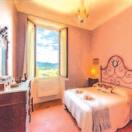


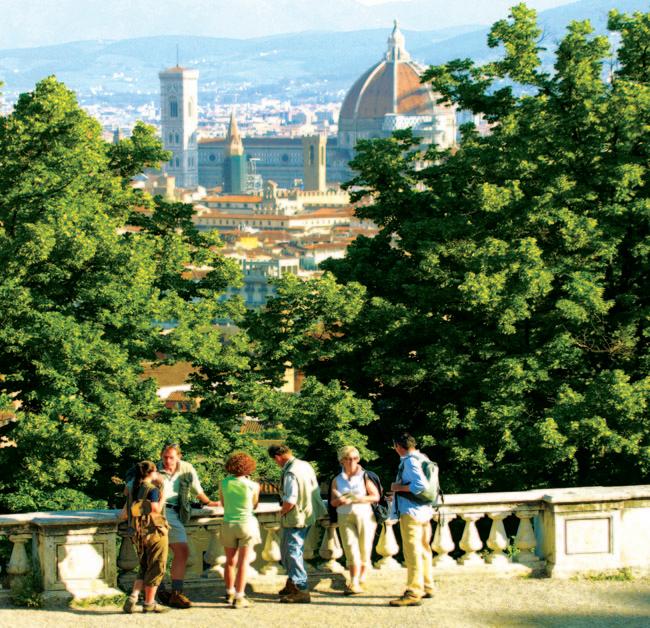
Descending into the heart of Florence

Specialists have conducted much research to identify the origins of Chianti as a wine. The Lega (League﴿ of the three regions of Chianti (Castellina, Radda and Gaiole﴿ incorporated rules governing the vendemmia (the grape harvest﴿ into their code of law as early as 1384. In 1444 the stipulation was made that no grapes should be harvested before Saint Michael’s day (29 September﴿, to avoid the ‘damage done to the League by harvesting earlier because the wines could not be good’. These measures were so successful that the wine produced within the
&
Lega (the area generally thought of as Chianti ‘proper’, corresponding in wine terms to
u Vineyards in flower
u Castles and fortified, medieval villages
u Cypress trees and forested hills
Chianti’s cuisine is a microcosm of Tuscan cooking in general. Add to its base of bread, pasta and wine a plentiful and changing supply of locally grown vegetables and fruit, game from the forests and, of course, the ubiquitous olive oil, with its peppery, spicy bite. We walk through vineyards producing some of the superb red wines of the area, including the fruity Chianti Classico.
Forested limestone hills, the lower slopes covered with vineyards and olive groves. A wide selection of farm and forest paths and tracks, small gravel roads and some asphalt in and around towns.
the current territory of Chianti Classico﴿ became famous for its quality, and remains so today.

Ancient volcanic landscapes punctuated by three lakes providing the backdrop for inspiring walking; two fascinating gardens, medieval towns, and Orvieto, with its magnificent cathedral.
ITINERARY
Day 1 After arrival at Rome Fiumicino airport we transfer to Ronciglione and our lakeside hotel. We visit the splendid Villa Farnese at Caprarola, an extensively frescoed palace, then explore its delightful 16th‐century gardens – that have influenced garden design worldwide.
Day 2 We walk from Trevignano Romano through woods and across farmland to historic Sutri, with its famous frescoed pilgrim church of the Madonna del Parto and impressive amphitheatre hewn from solid rock, before returning to our hotel (15 miles, 6 hours﴿
Day 3 We follow a track from the ancient crater of Lake Vico (2,935ft﴿ up through oak forest and across the Monti Cimini. From here, we walk down through chestnut groves and forest to the walled city of Viterbo (1,300ft﴿ and our centrally located hotel. Opportunity to visit the medieval quarter, the cathedral and infamous Papal Palace (8.5 miles, 4 hours﴿
Day 4 We follow small lanes across a plateau, and sections of superbly preserved, paved Roman road, to Montefiascone, with its castle and panoramic views across Lake Bolsena, and our hotel in the medieval centre (9 miles, 4.5 hours﴿
Optional excursion to visit the elegant formal 16th‐century gardens of the Villa Lante, its perpetual fountains supplied by a system – still functioning after over 430 years – using the natural flow of water.
Day 5 We walk along paths with panoramic views across Lake Bolsena, following an ancient Roman road before descending across meadows and through woods to the lakeside (opportunities for swimming﴿, and to the ancient town of Bolsena (11 miles, 5.5 hours﴿. Opportunity to explore Bolsena, the ’Church of the Miracle’ (of 1263AD﴿ etc.
Day 6 We walk up to the castle through Etruscan, Roman and medieval levels of Bolsena, then follow historic paths across a plateau to the great crag‐top city of Orvieto, where we stay in the medieval city (11.3 miles, 5.5 hours﴿
Day 7 Free day to explore Orvieto, with its magnificent cathedral and its iconic early 15th‐century fresco of the ‘Last Judgement’ by Fra Angelico and Signorelli; the well of San Patrizio – a double helix, 365ft deep, down which a flock of sheep could be driven to drink; Etruscan necropolis, museums, elegant cafés and bars, and good shopping.
Day 8 Return to Rome Fiumicino by road (1.5 hours﴿
8 DAY TRIP, ITALY
u Destination airport: Rome Fiumicino
u Continuous route*
u Fitness: Grade 2 ‐ 3
u Days of walking: 5
u Shortest/longest walk: 4/6 hours


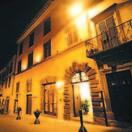

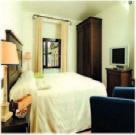
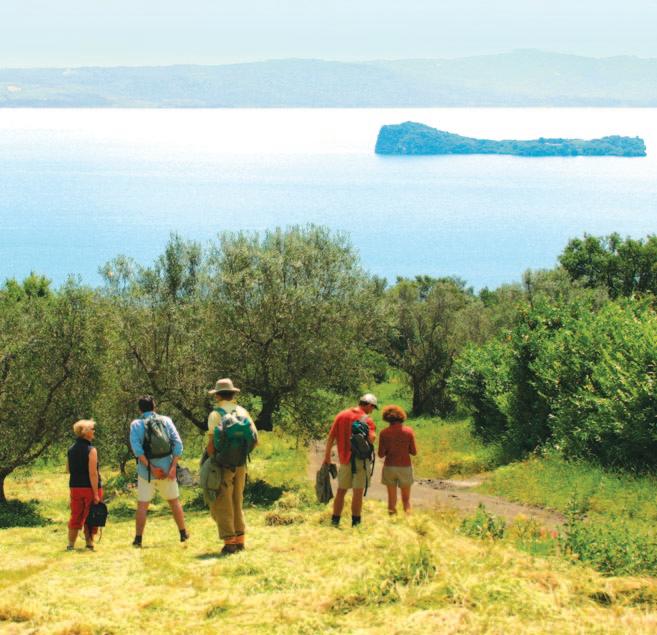
u Ancient volcanic landscapes
u Magnificent gardens
u Medieval towns
u Orvieto, with its magnificent cathedral
Very interesting cuisine combining influences of very strong flavours of Roman cooking – spicy pasta and hearty meat dishes; and the delicate cuisine of Umbria, with truffles, and fish from the lakes (we visit this area just to eat!﴿ Some notable trattorie en route, and outstanding restaurants in Viterbo and Orvieto. Local white wines include Orvieto Classico and Est! Est!! Est!!!
Low volcanic hills with long views across lakes, established paths through woods and vineyards, farm tracks and (near towns﴿ occasional stretches of asphalt.

Lakes Bracciano, Vico and Bolsena, north of Rome, are the result of volcanic activity that began 1,400,000 years ago causing the emergence of the Cimino Volcano (south of Viterbo﴿ The volcano reached its most active period – producing lava cones – around 950,000 years ago.
Lakes Bracciano and Vico are more recent, dating from 400,000 years ago, with the majority of the caldera and lava flows dating from between 300,000 to 150,000 years ago.
Lake Bolsena, the largest volcanic crater lake in Europe, was formed around 370,000 years ago following the collapse of a caldera,
in the Volsinii volcanic complex, into a deep aquifer beneath the underlying Miocene‐Pliocene sedimentary sands and clays. The two islands in the southern part of Lake Bolsena were formed by underwater eruptions following the initial collapse of the caldera Roman historic records indicate activity in the Volsinii volcanic area as recently as 104 BC, since when it has remained dormant.
The area’s porous volcanic terrain has been subject to water erosion, especially by rivers, creating deep ravines and gorges. The occurrences of sulphurous hot springs are reminders of the area’s distant origins. Land surrounding
the lakes, whether farmland or forests, is very strictly controlled, preserving the ecology and natural beauty of each area, whilst water in all the lakes (where you can swim﴿, is some of the cleanest in Europe. Lake Bracciano is the principal source of drinking water for Rome.

Fine walking along the ancient olive grove route, famed medieval towns on Roman foundations, outstanding art, excellent hotels, good food and Sagrantino wine, and following in St Francis’ footsteps.
Day 1 From Rome Fiumicino airport we travel by road to the medieval hill town of Spoleto where we stay at an elegant 4* palazzo convenient to the medieval city (2 hours﴿
Day 2 From Spoleto we follow farm tracks through olive groves and a succession of small, picturesque medieval villages with long views across the wide Umbra Valley, to Poreta, with its castle and extensive medieval walled defences (11.5 miles, 6.5 hours﴿
Day 3 Small lanes and tracks lead up to Campello Alto, a delightful medieval hilltop village with wonderful views, and then on to the village of Pissignano, with its majestic 11th‐century castle. Ancient olive grove terraces lead us via spectacular scenery and a Roman aqueduct to the ancient hilltop town of Trevi, with its excellent churches and museums housing numerous art treasures – frescoes by Perugino and Lo Spagna – and interesting museum of olive oil (8.1 miles, 5.5 hours﴿
Day 4 We continue along the slope of Monte Serano, offering splendid views over the valley. We walk via a series of tiny,
remote hilltop villages, Roman settlements and an impressive ‘keep’ before descending to Carpello (9.2 miles, 5 hours﴿
Day 5 Paths lead gently up through oak forests and olive groves to the impressively situated 11th‐century Benedictine Abbey of Santa Croce in Sassovivo, with important artistic and architectural features. We then descend gradually, through juniper and pine forest, via waterfalls and ancient hamlets, across the Topino Valley, up and on to the splendid Roman, medieval town of Spello (13.4 miles, 7 hours﴿
Day 6 We set off early to climb the high flower‐filled pastures of Monte Subasio (1,290m / 4,232ft﴿, or take a ride to near the top – to enjoy astonishing views. We descend along the path walked by St Francis into the heart of Assisi and the city's best hotel (5H﴿ (11 miles, 2.5 + 4 hours﴿
Day 7 Free day to explore Assisi, or visit the nearby Carceri hermitage, San Damiano or Santa Maria degli Angeli.
Day 8 Return to Rome
Fiumicino airport by road (2.5 hours﴿
8 DAY TRIP, ITALY
u Destination airport: Rome Fiumicino
u Continuous route*
u Fitness: Grade 3 ‐ 4
u Days of walking: 5
u Shortest/longest walk: 5/7 hours
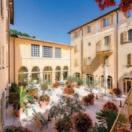

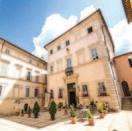

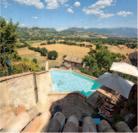
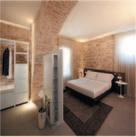
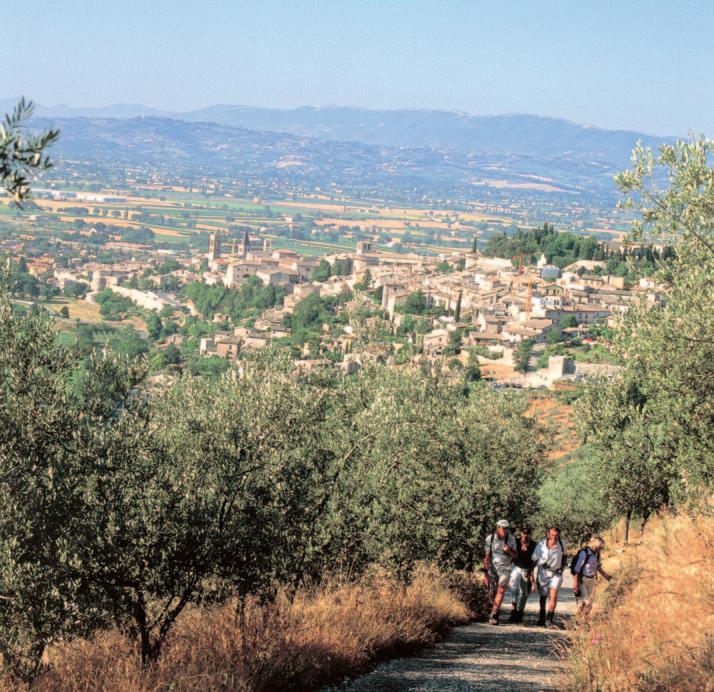
u The ancient olive grove route
u Orchids and fritillaries, high pastures
u Castles and hilltop villages
u Assisi, with its world‐class art and architecture
Restaurants of distinction and a wide range of hearty Umbrian dishes. Original seasonal recipes with game, mushrooms, asparagus, artichokes and black truffles.
Nearby Montefalco is renowned for being one of Italy’s most innovative wine‐making areas, especially Rosso di Montefalco and Sagrantino DOCG, with its incomparable passito variety.
Ancient olive grove and mule tracks, woodland paths, grassy meadows, forest paths, stony tracks. Some steep ascents and descents.

Assisi is, of course, the birthplace and shrine of one of history’s most famous saints –St Francis (San Francesco﴿, and as such is full of important monuments and works of art. Assisi’s first saint was not St Francis, however, but St Rufino, an evangelist of the Roman town Asisium, who was martyred here in 238 AD.
Although a fine Romanesque church dedicated to St Rufino exists, it is St Francis and his disciple St Clare (Santa Chiara﴿
who have inspired the most famous of Assisi’s monuments. The vast Basilica di San Francesco attracted many of the finest artists of the age to decorate its expanse of walls with frescoes, including Giotto, whose fresco cycle showing the life of St
Francis is famed throughout the world.

Idyllic countryside where a range of micro‐climates and terrain provide an abundance and variety of species, including orchid variance and hybridisation. Easy walking. Great hotels!
ITINERARY
Day 1 After arrival at Rome Fiumicino airport we travel by road (2.5 hours﴿ to the picturesque Nera Valley in Umbria, where we spend three nights.
Day 2 We walk along the Nera Valley, with its swift‐flowing river, fertile meadows and abundance of flowers, including lizard orchids; and visit an abbey church with remarkable frescoes (restored by the ATG Trust﴿ and the tombs of the Longobard dukes of Spoleto (6.5 miles, 3 hours﴿. Optional afternoon visit to the extraordinary Cascate delle Marmore: ancient Roman‐built waterfalls, some of the tallest in Italy.
Day 3 We walk through mountain meadows enjoying a profusion of flowers (3.5 miles, 3 hours﴿. Optional afternoon walk along a flower strewn lane with lovely views across the Nera Valley (3 miles﴿
Day 4 We walk along the picturesque Campiano Valley (4 miles, 2.5 hours﴿, before continuing to the walled medieval town of Norcia in a valley of the Monti Sibillini, where we spend four nights.
Day 5 A drive (35 mins﴿ brings us to the rim of hills overlooking the Piano Grande, a grassy highland plain, where we walk and discover a range and profusion of flowers (3.5 miles, 3 hours﴿, before visiting the village of Castelluccio.
Day 6 We walk along the pretty wooded fringes of the plain of Santa Scolastica, enjoying gentle farmland and birdsong (5 miles, 2.5 hours﴿
Day 7 We drive into the Monti Sibillini (40 mins﴿ to walk and enjoy a profusion of flowers and views in the high hills (3.5 miles, 3 hours﴿. On our return we pause to explore the grassy scree slopes of Monte Vettore (8,123ft / 2,476m﴿ where trumpet gentians and other interesting species grow.
Day 8 We return by road to Rome Fiumicino airport (3 hours﴿
8 DAY TRIP, ITALY
u Destination airport: Rome Fiumicino
u Fitness: Grade 2
u Days of walking: 6
u Shortest/longest walk: 2.5/3 hours
ACCOMMODATION
1-3
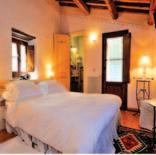
4-7
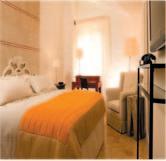
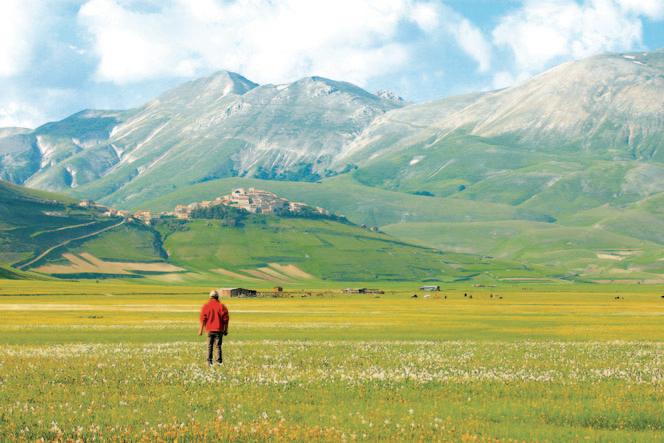
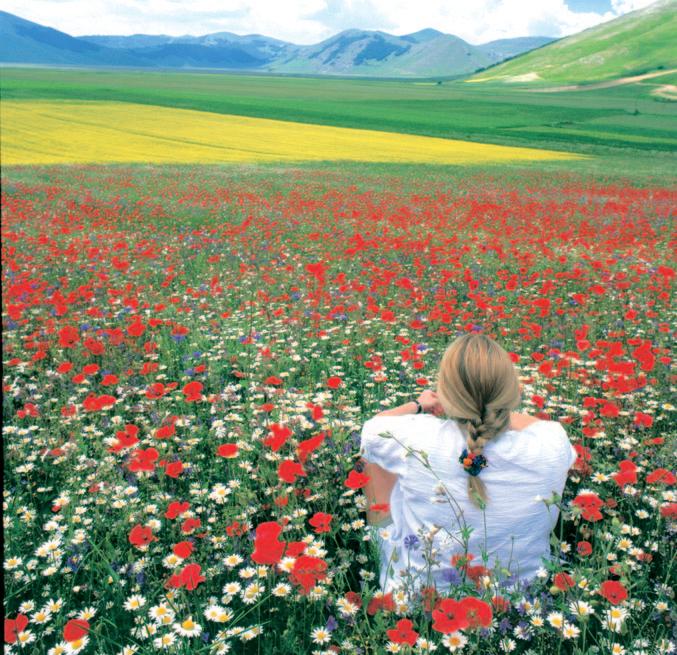
An astonishing profusion of flowers

The Romanesque Abbey of San Pietro in Valle is the only existing building directly linked to the history of the Lombard Duchy of Spoleto and provides an excellent record of life and art through the medieval ages. The abbey was founded in 742, and the present church dates from a reconstruction in the 10th‐11th century. In 2013‐14 the ATG Trust funded the restoration of the fresco in the right apse entitled ‘Madonna and Saints’, dating from the 14th century, which was in a terrible state of repair. It had been badly degraded by damp and previous poor restoration work undertaken in the 1930s and 40s. Sadly, a patch of the fresco was so badly degraded that it has had to be left as bare plaster but the restorers are very pleased with the overall result. We hope you will be too!
u One of the most beautiful areas of Europe
u An astonishing variety and profusion of flowers: from pastures of narcissi and wild tulips, gentians, fritillaries, to hybrid and limadore orchids
u ‘A must for anyone who enjoys flowers’
Delicious food, with black Umbrian truffles of Norcia; trout from the rushing river Nera; world‐famous Castelluccio lentils; and of course, Norcineria – hams and salami for which the area is famous. We enjoy local wines of the Nera Valley and Spoleto, the prized DOCG reds of Montefalco, just west of the area we visit and the renowned DOCG whites of Orvieto to the north.
Woodland, sheep and mule tracks, dirt roads and high, open grassland with wide views. Wonderful grassy meadows and well‐made tracks.
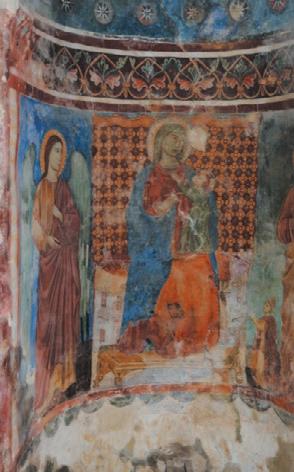
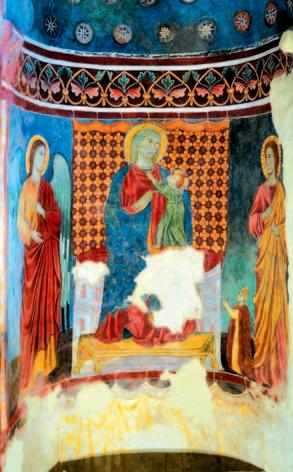
u Shortest/longest walk: 2.5/8 hours ITINERARY 15 DAY
Day 1 From Bilbao, we travel by road (2.5 hours﴿ to St‐Jean‐Pied‐de‐Port, the historic meeting place for travellers crossing the Pyrenees. We stay at the centrally located 4H Hôtel Les Pyrénées, with its excellent restaurant (H in the Guide Michelin﴿
Day 2 We walk up through meadows to the Col de Lepoeder (1,398m/4,585ft﴿, then down into Spain and the monastery of Roncesvalles, where we stay at the adjacent hotel (16.3 miles, 8 hours﴿
Day 3 We travel the Camino by road to the Romanesque church of St Mary of Eunate, before continuing on foot to Puente la Reina (3 miles, 1.5 hours﴿. After a transfer we then walk towards Santo Domingo de la Calzada, and visit the cathedral of Santo Domingo, with its live cockerel and hen. We stay at the 12C former hospital adjacent to the cathedral, now the 4H Parador de Santo Domingo (4.5 miles, 2.5 hours﴿
Day 4 After a brief transfer we walk to the pilgrim church of San Juan de Ortega. After lunch we continue on foot to the quaint village of Agés, before transferring to Burgos, where our hotel, the Mesón del Cid, is on the cathedral square (10 miles, 5 hours﴿
Day 5 Free day in Burgos, to visit the magnificent cathedral etc.
Day 6 We drive to Hornillos, then walk to the monastery of San Antón, before continuing to Fromista and the delightful Romanesque church of San Martín, before continuing by road to León (11.3 miles, 6 hours﴿
Day 7 We visit León’s superb cathedral etc. then drive to the bridge at Órbigo, famous for its association with Cervantes ‘Don Quixote’, before continuing to Astorga with its Roman walls, cathedral and Gaudí Bishop’s Palace. In the evening we experience an historic Maragato dinner at the picturesque village of Castrillo de los Polvazares.
Day 8 We walk across the Montes de León and down to the village of Molinaseca. Then after driving beyond Ponferrada, we follow paths through vineyards leading to the isolated church of Santiago with its historic Puerta del Perdón, from where we walk on to Villafranca (14.3 miles, 7 hours﴿
Day 9 We walk from the Valcárcel up to a ridge with panoramic views across Galicia, and to the village of O Cebreiro, with its Neolithic pallozas (round thatched houses﴿ (10 miles, 5 hours﴿
Day 10 Walk along a mountain ridge, with extensive views, and down to the village of Triacastela, from where we drive a short distance to Samos, where we visit the vast monastery and stay nearby (13 miles, 6.5 hours﴿
Day 11 From Sarria, we walk through farmland and stone‐walled pastures, past the Romanesque church of Barbadelo, where pilgrims would be accosted by agents of innkeepers in Santiago – still a week’s walk away, and continue through farmland, before descending to the River Minho, and crossing the ancient bridge to the village of Portomarín (14.3 miles, 7 hours﴿
Day 12 We drive to Santa Eulalia de Bóveda with its pagan temple, then walk along the original Jacobean way of the Camino del Norte to Vilar de Donas and its frescoed church (12 miles, 6 hours﴿. We then drive on to Rua de Arca.
Day 13 Walk through eucalyptus woods following the historic approach, via San Marcos, Monte do Gozo and finally into Santiago de Compostela. We stay at the historic 5H Parador dos Reis Católicos superbly situated on the cathedral square (13 miles, 6.5 hours﴿
Day 14 Free day to explore Santiago de Compostela.
Day 15 Transfer to Santiago de Compostela airport (20 mins
u Arrival/departure airport: Bilbao/Santiago
u Continuous route*
u Fitness: Grade 3 ‐ 4
u Days of walking: 10
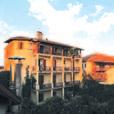
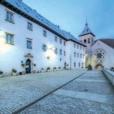




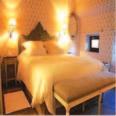


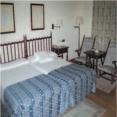



u Europe's most famous medieval pilgrim route
u From the Pyrenees across plains, hills and valleys of northern Spain
u Great cathedrals, pilgrim churches, monasteries and memorable walking…
Good cart tracks, mule, cattle and forest paths, and dirt roads.
This trip features Basque, Castilian and Galician cooking. The cuisine of the Basque country is vigorous and hearty. Caught, gathered or hunted in the wilds, the food’s piquant seasoning distinguishes it from other areas. Basque cuisine also includes plenty of fresh fish from the Atlantic. The Castilians are fond of sumptuous soups and stews prepared with fresh meat, sausages and vegetables which are full‐bodied, wholesome and filling but never compromise on flavour. Galician food is simple, using good local ingredients to complement the robust wines of the region. This trip passes through several wine regions of note, not least La Rioja and Navarra. We try the best of the wines of these regions.
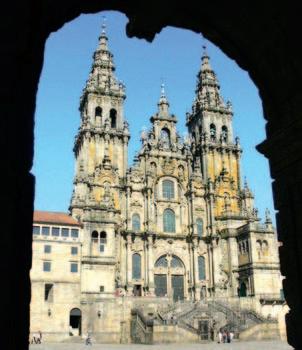
A world‐class walk, with the flowers at their best (May/June trips﴿. Wonderful country, views, picturesque villages, fine frescoed churches, some excellent hotels and cuisine.
Day 1 Drive (2.5 hours﴿ from Rome Fiumicino airport to the walled medieval town of Norcia, famous as the birthplace of St Benedict and for its hams, salamis – norcinerie – and world‐renowned black truffles! We stay for 3 nights in an elegantly converted palazzo just off the central piazza, with a H Michelin restaurant.
Day 2 We explore the idyllic, grassy highlands of the Monti Sibillini, including the Piano Grande – a vast mountain plain, that bears carpets of flowers from late May to July and is overlooked by the isolated medieval village of Castelluccio, famed for its delicious, tiny lentils (8 miles, 4.5 hours﴿ Optional afternoon walk to explore more of the area.
Day 3 We return to the Monti Sibillini and follow paths leading over hills with views across the Piano Grande, before descending towards our picnic (10 miles, 5 hours﴿. After lunch we continue to Norcia.
Day 4 We walk through oak woods and across farmland to the small town of Cascia, a centre of pilgrimage for St Rita, patron of desperate causes.
From here an old pilgrim path follows the steep‐sided river valley to Roccaporena, a hamlet dramatically situated at the junction of three gorges, and the saint’s birthplace (13 miles, 6.5 hours﴿
Day 5 We cross hills with scrub and oak woods famous for truffles, climb to a ridge from which there are panoramic views, then walk down to the picturesque village of Gavelli, with the finest small frescoed church in Italy (former ATG Trust restoration project﴿. From here we descend into a gorge that leads down to medieval Scheggino on the River Nera (12.8 miles, 6.5 hours﴿
Day 6 Optional walk along the picturesque Nera River valley to the church of San Pietro in Valle, to see remarkable 12th‐century frescoes including one restored by the ATG Trust (5.9 miles, 3 hours﴿
Day 7 From Scheggino we walk through wooded hills, offering wonderful views, and descend through chestnut woods and olive groves to the delightful, medieval city of Spoleto (12.3 miles, 6 hours﴿
Day 8 Return to Rome Fiumicino airport (2.5 hours﴿
8 DAY TRIP, ITALY
u Destination airport: Rome Fiumicino
u Continuous route*
u Fitness: Grade 3 ‐ 4
u Days of walking: 6
u Shortest/longest walk: 3/6.5 hours

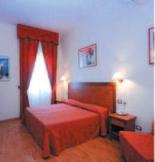

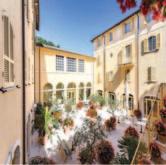

u Great walking! From high, flower‐filled Apennine pastures to hills and gorges; historic stone villages, frescoed churches…and Spoleto.
From the tastes and textures of the Marche, to Umbrian black truffles, cured meat and unique green lentils for which Norcia is famous throughout Italy and beyond; trout fresh from mountain streams, tagliolini with truffles, lenticchie, lamb with mountain herbs and sheep's cheeses. Wines from Montefalco and the Adriatic coast.
Woodland, sheep and mule tracks, dirt roads and high, open grassland with wide views. Wonderful grassy ridges and well‐made tracks on most ascents and descents, some of which are steep. Walking poles highly recommended.

From the hills around Lake Garda to the incomparably picturesque mountain scenery of the Brenta Dolomites. Hotels with pools and spa. Excellent walking, food and wine.
Day 1 After arrival at Verona airport we travel by road (30 mins﴿ to the hills to the east of Lake Garda where we stay in a wine‐growing area for three nights.
Day 2 We walk following paths through olive groves and vineyards, and past prehistoric rock carvings, down to the lake and town of Garda (5 hours﴿
Day 3 We drive (35 mins﴿ up into Lake Garda's eastern mountain range, which is popularly known as Europe’s botanical garden. We walk through meadows and mixed woods before ascending to the top of a ridge dotted with vestiges from World War I. We continue along the top of the ridge enjoying magnificent views of the lake and the Adige Valley before beginning our descent back down to the starting point of the walk (4 hours﴿. We return to the hotel by road and enjoy a late afternoon wine tasting in the nearby Valpolicella region.
Day 4 A charter boat trip across Lake Garda brings us to the ‘Isola del Garda’ (also known as Isola Borghese﴿ with its Venetian/ neo‐Gothic 19th‐century villa and extensive Italianate and English gardens. After a private tour of the villa and opportunity to explore the park and gardens, we return to the lake shore by boat. We then drive (2.5 hours﴿ through fertile hill valleys to the Brenta Dolomites. Our mountain‐style hotel, situated near Madonna di Campiglio, has unrivalled views of the Brenta range, an indoor pool and spa and excellent restaurant.
Day 5 From Madonna di Campiglio, we ascend via well‐made paths and pastures to the granite Presanella, renowned for its lakes, great variety of flowers and excellent views of the Brenta (3, 5 or 6 hours﴿
Day 6 From Campo Carlo Magno we ascend in a cable car to the Grostè Pass at 2,442m. After time to enjoy the magnificent views, keen walkers descend from here to an intermediate station (1 hour﴿, while the others arrive via the cable car. From here we walk through flower‐filled meadows beneath the peaks of the Brenta, before descending through woods and past picturesque waterfalls to the valley and our hotel (3.5, 5 or 7 hours﴿
Day 7 We drive (15 mins﴿, then walk up into the Brenta following well‐made paths. The ascent to the first refuge (bar﴿, through woods, takes 1 hour 15 mins. From here we continue through mountain meadows, with extensive views, to a second refuge (restaurant and bar﴿, set in spectacular scenery with peaks, pinnacles and a glacier. We descend to the valley (5.5 or 7 hours﴿. Optional walk back to hotel via magnificent Cascate di Mezzo waterfall. NB. There are no cable car options for this walk.
Day 8 We return to Verona airport by road (2.5 hours﴿
8 DAY TRIP, ITALY
u Destination airport: Verona
u Fitness: Grade 3 ‐ 4
u Days of walking: 5
u Shortest/longest walk: 3/7 hours


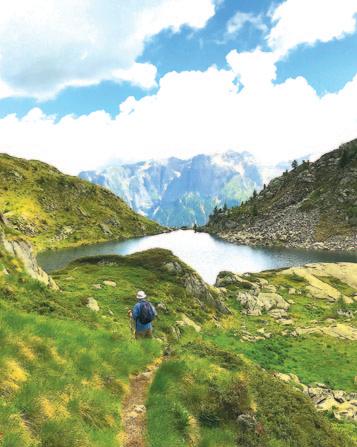

u Picturesque mountains
u Profusion of early summer flowers
u Excellent walking with spectacular views
u Wonderful hotels
Mountain cuisine with fresh produce from hills and mountain farms: lamb, cheeses, game, wild fruits, nuts and mushrooms. Produce from around the lake: olive oil, fruits from orchards and lemon groves; and maize (polenta﴿ and rice from the Po Valley. Wines from neighbouring Valpolicella, Bardolino and Soave, as well as some excellent reds and whites from the Alto Adige.
Well‐made and characteristic mountain paths. Walking through olive groves, vineyards, deciduous woodland, coniferous forest and flower‐filled mountain meadows. A range of walking possibilities each day; some optional ascents via cable car.

Walking through inspiring mountain scenery, along paths glittering with gypsum crystals, between historic cities famous for their architecture and art.
Day 1 We drive (20 mins﴿ from Bologna airport to Bologna and enjoy a tour of the inner city, before dinner in this renowned centre of gastronomy.
Day 2 We enter the Regional Park dei Gessi Bolognesi e Calanchi dell'Abbadessa … to walk on paths glittering with gypsum crystals and across the karst site of the ‘Dolina della Spipola’ to reach San Lazzaro di Savena (11.5 miles, 7 hours﴿
Day 3 We walk past Castel de' Britti, an ancient village built on the top of gypsum rocks, and cross the impressively eroded ‘Calanchi della Luna’ to reach the village of Settefonti, renowned for its impressive grey ravines and romantic legend ... from where we traverse ravines, enjoying fine views of the inner Apennines before walking up to reach Varignana (12 miles, 7 hours﴿
Day 4 We cross the notional border between Emilia and Romagna, walking through ravines, woods, orchards and pastures to Borgo Tossignano, at the Western end of the Vena del Gesso Romagnola (Romagna Gypsum Vein﴿ from where a short drive brings us to Casola Valsenio where we spend the night (14.5 miles, 8.5 hours﴿
Day 5 After returning by road to Tossignano, we walk to cross into the Vena del Gesso Romagnola, a small mountain chain made entirely of gypsum minerals, where the karst formations create a unique landscape. We follow a ridge, the Rive di San Biagio, enjoying extensive views of the Apennines and exploring the woods where a famous robber ‘Il Passatore’ once roamed, and arrive back at Casola Valsenio to spend the night (5 miles, 4 hours﴿
Day 6 We walk from the hotel down to Casola Valsenio and up into the eastern part of the Vena del Gesso Romagnola, where we find evidence of ancient gypsum workings, traces of the World War II Gothic Line on the slopes of Monte Mauro, before continuing to Brisighella, famous for its three towers and its excellent olive oil (13 miles, 8 hours﴿
Day 7 We drive (1 hour﴿ to Ravenna, where we spend the day visiting the city centre and its UNESCO World Heritage monuments, preserving the outstanding byzantine mosaics dating to 5th and 6th century. Free afternoon to enjoy the lively city centre.
Day 8 We return to Bologna airport (1 hour﴿
8 DAY TRIP, ITALY
u Destination airport: Bologna
u Continuous route*
u Fitness: Grade 3 ‐ 4
u Days of walking: 6
u Shortest/longest walk: 4/8.5 hours
ACCOMMODATION


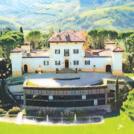


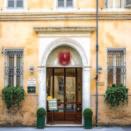
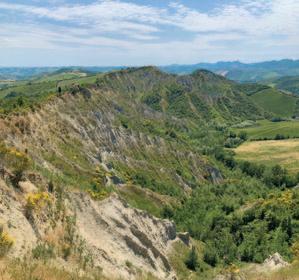

u Visit Bologna city centre with its UNESCO heritage covered streets and its artistic treasures
u Walking across the protected areas of the Evaporitic Karst and Caves of Northern Apennines (UNESCO site﴿
u Astonishing landscapes with astounding views and unique vegetation
u Visit Ravenna city centre with UNESCO heritage Byzantine mosaics and Dante Alighieri’s legacy
From handmade pasta to cured meats and local DOP and IGP products, Emilia‐Romagna is a hub for exquisite Italian produce. The exceptional local wines, such as Pignoletto DOCG, Sangiovese di Romagna DOCG, Albana di Romagna DOCG, Trebbiano, and Cagnina, add a delightful dimension to the gastronomic journey.
Farm tracks, mule paths, dirt roads, stony tracks, some tarmac on approach to towns, muddy terrain after rainfalls.

Ravenna, a jewel of Byzantine art, is renowned for its breathtaking mosaics that showcase the city's rich history. These intricate works of art, dating back to the 5th and 6th centuries, adorn the interiors of its UNESCO‐listed monuments. The Basilica di San Vitale features vivid depictions of biblical scenes, while the Mausoleum of Galla Placidia boasts a celestial night sky mosaic. Ravenna's mosaics, crafted with meticulous detail, employ a palette of vibrant colours and intricate patterns, showcasing the influence of Byzantine and Roman artistic traditions. The Basilica di
Sant'Apollinare in Classe displays a stunning mosaic depicting a vibrant procession of saints. These mosaics not only narrate religious stories but also serve as a testament to the city's cultural
and artistic significance during the Byzantine era. Today, Ravenna stands as a living museum, inviting visitors to marvel at these timeless masterpieces that have withstood the test of time.


Walk across the island... along ancient paths and tracks with long views. Abundant flower and bird species, remote picturesque villages, characteristic accommodation and traditional cuisine.
Day 1 After arrival at Catania airport we drive (1 hour﴿ to the ancient city of Enna, centrally situated high (1,000m/3,275ft﴿ on a great buttress of rock. We stay in the old town close to the cathedral and castle.
Day 2 We drive (30 mins﴿ to the village of Villadoro, from where paths and ancient drove roads cross gently rolling hills, with views to Mt. Etna, to the dramatically situated town of Gangi (11.7 miles, 6 hours﴿
Day 3 Time for relaxing or a visit to Gangi (3.8 miles, 2 hours﴿, before walking on. Paths across farmland lead to the route of an ancient road to the hilltop village of Geraci Siculo, with its ruined Saracen castle, Saracen fountain and picturesque alleys (8.2 miles, 5 hours﴿
Day 4 Paths through open mountain meadows, with extensive views, lead gently up to a ridge, where we stay at a comfortable mountain refuge. (11.6 miles, 6.5 hours﴿
Day 5 After an (optional﴿ walk to explore the nearby peaks, (6,493 ft /1,979 m﴿, we descend through inspiring scenery, past a nature reserve with fallow deer and wild boar, and through a geologically interesting
secluded valley, to the village of Isnello (8.1 miles 4.5 hours﴿
Day 6 After a short descent and stream‐crossing, farm tracks lead up to a ridge and pilgrim church with panoramic views – the sea! An ancient pilgrim path then leads down through woods and meadows, olive groves and vineyards; and through scrub to lemon groves, Cefalù and the sea (11.4 miles, 7 hours﴿
Day 7 We follow paths up, through woods and scrub, on to the massive buttress of rock behind Cefalù – to visit its Greek and Roman sites, and enjoy a panorama of the town and coast. Descending we explore Cefalù, its harbour, picturesque streets and alleys and not least its outstanding cathedral dating from 1131, with impressive 12th‐century Byzantine mosaics (4 hours﴿. In the afternoon we drive (1 hour﴿ to the cathedral of Monreale, the great masterpiece of medieval architecture, still preserved almost intact after eight centuries. We visit the cathedral with its superb Byzantine mosaics and fine cloister. Alternatively, stay behind to swim, relax or further explore this delightful place on your own.
8 DAY TRIP, ITALY
u Destination airport: Catania
u Continuous route*
u Fitness: Grade 3 ‐ 4
u Days of walking: 6
u Shortest/longest walk: 2.5/8.5 hours

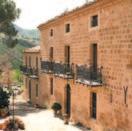


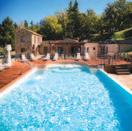
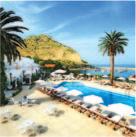
Day 8 We return to Catania airport (2.5 hours﴿

u Inspiring walking with long views
u Traditional mountain villages
u Outstanding birds, ancient trees and geological sites
Sicily’s interesting cuisine reflects the varied influences of invaders (Spanish, Arab, Greek﴿ over the millennia. Its varied style is also characterised by the intense and pure flavour of local ingredients. Famous for its rich and brightly coloured puddings, those with a sweet tooth will not be disappointed. Sicily (with Puglia﴿ is the largest producer of wine in Italy, and the wines are continually improving: excellent Rosso del Conte red and Nozze d’Oro white. There is also the well‐known dessert wine Marsala.
Drove roads, dirt roads, mule, mountain and rough animal paths across rolling hills and low mountains.

The Madonie – Parco delle
Madonie – was officially created in 1989, three years after the ATG walking route across the area was established. The park comprises about 39,972 acres (161.76km2/62.46 sq miles﴿ of mountain pastures and forest, and includes the Madonie Mountain range with peaks around 1,500m/4,900ft, and Pizzo Carbonara (1,979m/6,493ft﴿, the island’s second highest peak after Mount Etna.
Many of the hill and mountain villages, with their characteristic medieval buildings and alleys, are connected by ‘roads’, now grassy
tracks, some dating back 3,000 years to the indigenous Siculi, whilst others trace their origins to the Minoans and later invaders –Phoenician, Greek, Carthaginian and Roman.
Wildlife includes wolves, wildcats, deer and boar. There is a wide range of native birds, including several species of eagle. The park is on a major migration route between Europe and Africa. Amongst the migrants seen are flocks of cranes. Flowers are abundant, and in the forests are ancient, giant trees, and on the mountains the nearly extinct Nebrodi fir. Geologically the park is of outstanding interest with
rocks spanning over 200 million years.
In 1997, the Sicilian region recognised ATG’s pioneering development of tourism in the poorest areas of the island with a prestigious award.

Visit the finest Greek temples, stay on a Marsala wine estate, walk to see prehistoric painting on the island of Levanzo, explore dynamic Palermo and visit Monreale, with its superb mosaics.
ITINERARY
Day 1 After arrival at Catania airport we drive (2 hours﴿ to Agrigento, site of the ancient Greek city of Akragas, with its splendid Doric temples. We stay for two nights at a 4H hotel in the country, not far from the archaeological sites.
Day 2 We walk (2.5 hrs﴿, visiting the ‘Valley of the Temples’, an extensive archaeological site dating from the 6th century BC, including, amongst others, the majestic 5th‐century BC Temple of Concordia. We also visit the fine archaeological museum and explore some of the lesser known areas. Free afternoon: opportunity to swim in the sea or relax in the hotel's gardens.
Day 3 We drive (1.5 hours﴿ to visit the majestic ruins of Selinunte. We explore the site of this once‐great city – situated on two hills overlooking the sea, with its ruined temples, fortifications and other buildings dating back to the 7th‐century BC (2.5 hours﴿. Before travelling on, we discover that whilst the site may have been a flawed one for building a great city – it is perfect for an ATG picnic! We then continue to Marsala (1.5 hours﴿, stopping at a 5th‐century BC limestone quarry from which rock was extracted to build one of Selinunte's temples. Our hotel, where we spend two nights, is on a private wine estate.
Day 4
We drive (15 mins﴿ to visit the extraordinary salt pans of Marsala, and then take a boat across the lagoon to visit the Phoenician settlement of Mothia
(optional walk round the island, with its interesting remains, 1.5 hours﴿. Optional late afternoon walk (1‐2 hours﴿ through the picturesque vine‐clad estate.
Day 5 We travel by road (1 hour﴿ to the port of Trapani from where a hydrofoil takes us to the small, sparsely populated island of Levanzo (one of the Egadi Islands﴿. We travel by jeep or boat (depending on the conditions﴿ to visit a grotto with fine prehistoric cave paintings. Optional return to village on foot along a scenic, rugged coastal path (1.5 hours﴿. After returning to the mainland we continue by road to our hotel.
Day 6 We drive (45 mins﴿ to a picturesque coastal nature reserve and walk along a fine path with sweeping sea views and concealed bays (opportunities for swimming – 1‐3 hours﴿. After lunch, we drive (30 mins﴿ to visit the Temple of Segesta. Built in the 5th century BC, in Greek Doric style, by the Elimi people, whose origins are unknown, it is one of the most perfectly preserved monuments to survive from antiquity. We continue by road to Palermo (1 hour﴿, where we stay for two nights.
Day 7 We spend the morning exploring the vibrant historic centre of Palermo, visiting some of its most important churches and oratories with a local guide. After lunch we drive (25 mins﴿ to Monreale, to visit its cathedral, the great masterpiece of medieval architecture, still perfectly preserved after eight
u Destination airport: Catania
u Fitness: Grade 2
u Days of walking: 5
u Shortest/longest walk: 1.5/4 hours
8 DAY TRIP, ITALY ACCOMMODATION
1 & 2
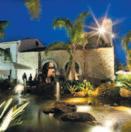


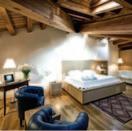
centuries, with its superb Byzantine mosaics and fine cloister. Return to Palermo to enjoy further sightseeing or relax at the hotel, before walking out to dinner in a restaurant.
Day 8 We visit the Palazzo dei Normanni, the Cappella Palatina and famous 'royal apartments', and after lunch we drive (20 mins﴿ to the cathedral of Monreale, the great masterpiece of medieval architecture, still perfectly preserved after eight centuries. We visit the cathedral with its superb Byzantine mosaics and fine cloister, then continue by road (2 hours﴿ to Catania airport.


From the hilltop of Monte Bàrbaro (305m/1,000ft﴿, site of the ancient city of Segesta, built by the Elimi – an ancient people of unknown origin – are panoramic views: on one side across a deep valley to the sea (Gulf of Castellamare﴿; and on the other, beyond remains of walls, towards ‘the best‐preserved monument from antiquity’ – the Temple of Segesta, presenting us with more questions than answers.
Built in the late 5th century BC, the temple, with its 36 simple Doric columns, appears not to have been finished. The columns have not been fluted as they
normally would have been in a Doric temple and there are still tabs present in the blocks of the base (used for lifting the blocks into place but then normally removed﴿. It also lacks a cella, or inner chamber or sanctum, and was never roofed over. The temple is also unusual for being a
u Iconic Greek temples
u Marsala vineyards
u Prehistoric island art
u Wonders of Palermo FEATURES
Sicilian cuisine is one of contrasts: simple peasant cooking and the richer, more exotic styles of the invading civilisations. Its varied style is also characterised by the intense and pure flavour of the local ingredients.
Sicily (with Puglia﴿ is, perhaps surprisingly, one of the largest wine regions in Italy, producing excellent Rosso del Conte red and Nozze d’Oro white.
Archaeological sites, farm tracks through vineyards, limestone island and coastal tracks and paths.
Hellenic temple in a city not mainly populated by Greeks.
And then, when the adjacent city was destroyed, and even later structures, such as a medieval mosque, were reduced to rubble, why did this exquisite building remain untouched?

Exploring Sicily’s famous Baroque towns, Greek temples at Siracusa, and prehistoric crag‐top Pantalica; walking on volcanic, snow‐capped Mount Etna and relaxing in luxury at Taormina.
Day 1 After arrival at Catania airport we drive south west to Ragusa, where we stay for two nights in the historic, Baroque centre at a beautifully converted boutique hotel with excellent restaurant.
Day 2 We drive (10 mins﴿ then walk (3 miles, 1.5 hours﴿ through a quiet valley to the delightful Baroque hill town of Ragusa Ibla, with its fine churches, palaces, piazzas and views. Like other towns in the south‐east of the island, it was destroyed in the 1693 earthquake, and rebuilt using creative interpretations of Baroque style. Free afternoon or optional walk through a lovely gorge (4 miles, 2.5 hours﴿
Day 3 We drive (25 mins﴿ to the Baroque town of Modica, rising spectacularly on a hillside, then walk through its narrow maze of streets to the cathedral of San Giorgio (2 miles, 1 hour﴿ From here we continue to Noto Antica (1 hour﴿, where we walk (3 miles, 1.5 hours﴿ amongst its ruins in a spectacular setting, before visiting the 'new' town of Noto (a UNESCO World Heritage site﴿, with its many exquisite Baroque buildings. We then drive to Siracusa (45 mins﴿, where we stay on the island of Ortigia.
Day 4 Free morning to explore some of the city’s outstanding places of interest, followed by a guided tour of the San Giovanni catacombs. In the afternoon we visit the excellent Paolo Orsi Archaeological Museum. We then explore the ancient Greek site of Siracusa, with its astonishing Greek theatre, its temples, and other delights in its garden setting.
Day 5 We walk down through Ortigia’s colourful food markets before driving (1 hour﴿ to the Anapo gorge, a protected area of outstanding natural beauty. We walk to explore the ancient site of Pantalica, inhabited since the Bronze Age, with over 5,000 burial chambers carved into the steep cliffs of the gorge – the largest necropolis in Europe (6 miles, 3.5 hours﴿. In the afternoon we drive to Taormina (2 hours﴿, perched dramatically above the coast.
Day 6 We drive (1.5 hours﴿ to the flanks of Mount Etna (1,700m﴿, where we walk through startling volcanic landscapes and delightful silver birch woods (4 miles, 2 hours﴿ to lunch in a mountain refuge, before returning to Taormina.
Day 7 Morning visit to Taormina’s Greek/Roman theatre and free time to enjoy the town before returning to Catania airport (50 mins﴿
Small lanes and dirt tracks, gravel and volcanic ash paths; gentle mountain walking on Mount Etna.
7 DAY TRIP, ITALY
u Destination airport: Catania u Fitness: Grade 1 ‐ 2
u Days of walking: 4
u Shortest/longest walk: 1/3.5 hours
NIGHTS 1 & 2

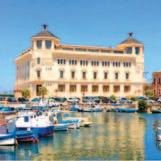





u Superb Sicilian Baroque towns
u Greek sites at Siracusa
u Walking high on Mount Etna & Taormina
The Sicilians readily admit to the influences of the past: pasta came to Sicily with the Arabs; the Greeks introduced wine, honey and olives; the Byzantines brought sharp, pungent cheeses and spicy biscuits; the Normans salt cod; and the Spanish the infamous tomato sauce and sweet and sour flavours. Fish is one of the glories of Sicilian cooking, prepared in every possible way, including exotic fish stews. Popular white grape varieties include Insolia, Catarrato, Grillo and Caricante, (this last grown almost exclusively on Mount Etna and the basis of Etna Bianco Superiore﴿; and red wine production is dominated by the Nero d'Avola grape. The Sicilian islands also produce some lovely white dessert wines based on Moscato (Muscat﴿ and Malvasia grapes.

Archimedes of Syracuse, the mathematician, philosopher and inventor, was born in Siracusa (Syracuse﴿ in 287 BC, and educated in Egypt, at Alexandria, after which he returned to Syracuse, where he spent most of the rest of his life, devoting his time to research and experimentation.
In mechanics he defined the principle of the lever and is credited with inventing the compound pulley and the hydraulic screw for raising water. He is most famous for discovering the law of hydrostatics, also known as the ‘Archimedes Principle’, stating that a body immersed in fluid loses weight equal to the
weight of the amount of fluid it displaces. Archimedes is supposed to have made this discovery when taking a bath – and then ran down the street shouting ‘Eureka!’
During the Roman conquest of Sicily in 214 BC Archimedes applied his talents to the city’s defence. Amongst the devices attributed to
him are the catapult and a, perhaps legendary, system of mirrors to focus the sun’s rays to set fire to the invaders’ ships.
Archimedes died during the capture of Syracuse. It is said he was so absorbed in his calculations, that he told his killer, a Roman soldier, not to disturb him....

Walk through the wooded Langhe hills and Barolo vineyards: a picturesque patchwork interspersed with woods, hilltop villages and castles. The area is famed as much for its food as its renowned wines.
Day 1 We travel by road from Turin airport (1.5 hours﴿ to the lovely hilltop town of Mondovì, founded in 1198, overlooking the Maritime and Ligurian Alps, the Langhe Hills and the fertile plains stretching all the way to Turin.
Day 2 After a brief transfer to Ceva (20 mins﴿, we walk up to a ridge affording superb views of both the Maritime and Ligurian Alps. We pass farmland, mixed woods, fields of lavender and other medicinal herbs, before descending into a valley. An ascent along forest tracks to another ridge takes us past the site of a battle during the French Revolutionary Wars led by Napoleon. We then descend to a secluded valley before another brief ascent to the hamlet of San Luigi (11.1 miles, 6.5 hours﴿
Day 3 We pass through a remote valley and then ascend along forest tracks to a ridge, and on to the charming medieval village of Murazzano. After exploring the town we continue along another ridge via hazelnut groves, fields and mixed woods, enjoying superb views of the Alte Langhe, before reaching what is locally referred to as the ‘Village of the Roses’, or the ‘Pearl of Le Langhe’, Bossolasco (11.7 miles 6.5 hours﴿ Then continue on, enjoying wonderful views, to the hamlet of Bossolaschetto (13.9 miles, 7.5‐8 hours﴿
Day 4 We follow paths across hills, through woodland and meadows (flower‐filled in spring﴿ We then emerge amongst vineyards of Nebbiolo (the grape variety used for producing Barolo﴿, before arriving at the small bustling ‘wine town’ of
Monforte d’Alba, and an elegant Bourbon villa at the top of the town, where we stay for two nights (8.2 miles, 4 hours﴿
Day 5 Free day in Monforte d’Alba with an optional walk along the crest of the hills behind Monforte affording wide views of the Barolo vineyards, to Castiglione Falletto, where we visit a local wine producer and taste the wines (4.3 miles, 2.5 hours﴿. We continue on foot (or van transfer﴿ into a valley, then ascend through vineyards to Serralunga d’Alba (2.9 miles, 2 hours﴿. Return to Monforte d’Alba on foot (3.2 miles, 2 hours﴿ or by van.
Day 6 A ridge route leads us down into a wide ‘bowl’ in the hills – covered with some of the area’s most renowned vineyards – to the small town of Barolo, which gives the area its name. We visit Barolo’s wine museum and renowned enoteca to enjoy a tasting of the region’s world‐famous wines. We continue through vineyards up to La Morra, overlooking much of the area, and noted for its fine Baroque churches and palaces (5.5 miles, 4 hours﴿
Day 7 La Morra to Alba: Descend through vineyards to picturesque Verduno, and then continue along a ridge to Roddi (5 miles, 2.5 hours﴿. Then, after a brief transfer to Alba (Europe’s white truffle capital!﴿, optional circular walk (6.5 miles, 4 hours﴿ in the surrounding vine‐clad hills. Or, time to explore the town.
Day 8 Transfer from Alba to Turin airport (1.5 hours﴿
8 DAY TRIP, ITALY
u Destination airport: Turin
u Continuous route*
u Fitness: Grade 3
u Days of walking: 6
u Shortest/longest walk: 4/6.5 hours

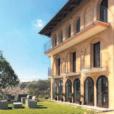

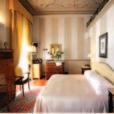


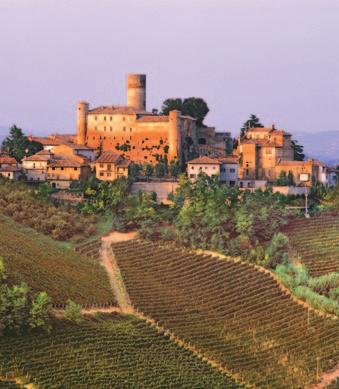
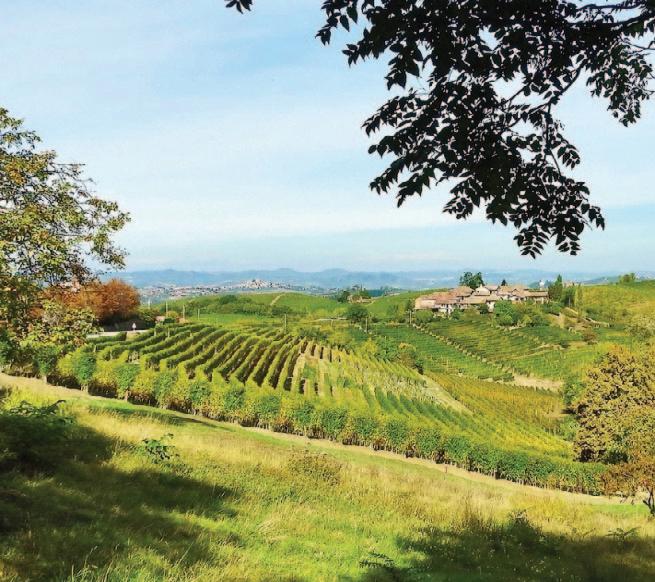
u Views across vine‐clad hills to the Alps!
u Picturesque hilltop towns
u Famous vineyards, great wines
u Excellent Piedmont cuisine
Piedmont is renowned for its gastronomy, offering refined country cooking which follows the seasons. Its most prized ingredient is the white truffle (in season﴿, but you can also expect game cooked in wine, delicate risottos and innovative desserts. We walk through vineyards producing some of Italy’s most outstanding wines, including the renowned Barolo and Barbaresco, and the lesser‐known Dolcetto, Barbera and Moscato d’Asti.
Gentle, rolling hills following well‐made dirt roads, paths through vineyards, farm and woodland tracks.

Footnotes
As a producer of fine red wines, this region of Italy is possibly unequalled. The 1,600 foot Langhe hills, through which we walk, provide the slopes, shelter, soil, sunshine and humidity that bring the Nebbiolo grape – from which derives three of Piedmont’s most important wines – to perfection in Barolo. The Nebbiolo takes its name from the fog (nebbia﴿ that characterises the area in the autumn, producing wonderful, mellow views. ‘Overwhelming’ and
‘uncompromising’ are terms often used to describe Barolo. After fleeting scents of fruits or flowers, the aroma turns to powerful tar, liquorice, coffee, leather etc. For the uninitiated, the palate can be a real struggle! Off‐putting though the high level of tannins and acidity can be, they promote Barolo’s prized feature: its expansive and velvety texture, the result of a lengthy aging process: 5 years minimum for a Riserva, ideally 10 years. Barolo excels in the context of the region’s cuisine

– among the best in Italy – as the perfect complement to game, roast and red meats, rich casseroles and pungent cheeses. With every mouthful there is something new to be discovered – one of the hallmarks of a great wine.
High coastal walking with excellent views; the Foresta Umbra, the best‐preserved area of ancient woodland in Puglia; fine Romanesque churches and Monte Sant’Angelo; perfect time for swimming in the sea and delicious seafood.
ITINERARY
Day 1 After arrival at Bari airport we travel by road to the heart of the Gargano National Park and our hotel in a spectacular setting (2 hours, 15 mins﴿
Day 2 We walk to discover the Foresta Umbra, a UNESCO World Heritage Site and the best‐preserved area of ancient woodland in Puglia, with an abundance of birds and animals and more than 65 different types of orchids (5 miles, 3.5 hours﴿. After lunch, optional 1.5‐hour walk, before visiting the picturesque fishing village of Peschici, its narrow alleys of cliff‐top whitewashed houses perched on the eastern edge of the Gargano Peninsula.
Day 3 From the high massif we follow tracks and paths through pine forests and pastures with panoramic views of the coast, before descending to a cove. After lunch, a spectacular coastal walk brings us to the harbour of Vieste (12 miles, 6 hours﴿
Day 4 In the morning we enjoy (weather‐permitting﴿ a boat trip along the picturesque Gargano coast. After a brief transfer by road we reach our lunch spot in the Gargano National Park. We then walk back to Vieste, enjoying wonderful views of the coast (7.7 miles, 4 hours﴿
Day 5 After a brief transfer we follow paths and tracks through woods, limestone hills and scrub to a viewpoint (340m / 1,115ft﴿, before descending to follow a picturesque coastal path to the bay of Fontana delle Rose, and the exquisite beach of Mattinatella (8.3 miles, 4 hours﴿ A brief transfer brings us to the small harbour village of Mattinata.
Day 6 Follow paths across Monte Saraceno, with extensive views overlooking the sea and an archeological site (7.1 miles, 3.5 hours﴿. Free afternoon to explore Mattinata, with optional town walk.
Day 7 We drive (45 mins﴿ to Monte Sant'Angelo, with its whitewashed hoses, steen narrow alleys and stairways. Time to explore the town and visit the famous cave church, venerated as being the last place St Michael appeared on Earth in 491 AD. Optional afternoon walk down an ancient, well‐made pilgrim path back to Mattinata (9.2 miles, 5 hours﴿
Day 8 We return to Bari airport (1 hour, 45 mins﴿
8
u Destination airport: Bari u Fitness: Grade 3
u Days of walking: 6
u Shortest/longest walk: 4/6 hours

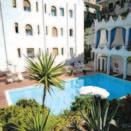
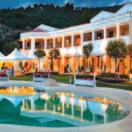
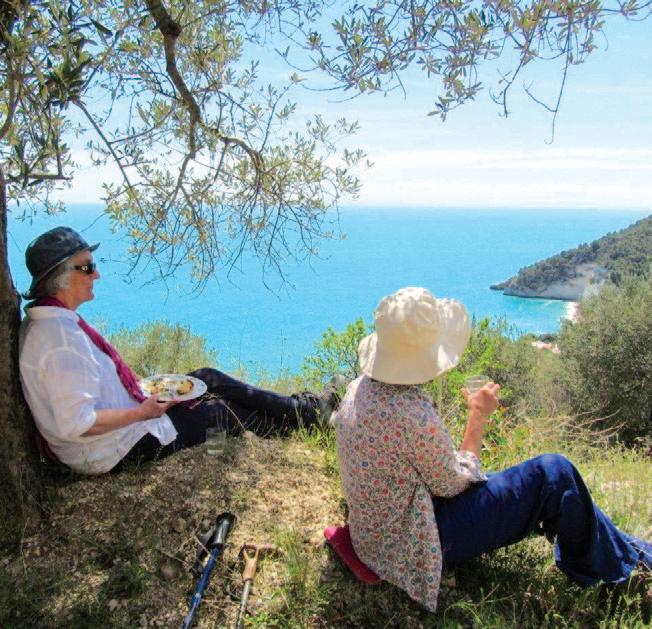

The town of Monte Sant’Angelo is perched on a limestone promontory 800m/2,620ft above the Adriatic coast. In spring the meadows surrounding the town are carpeted with orchids. The town developed around a cave, the oldest shrine in Western Europe, which is revered as the last place that the Archangel Michael appeared on Earth – to the Bishop of nearby Siponto, in 490 AD. The attributed date of the appearance, 8 May, relates to another appearance of the archangel – with flaming sword – prior to a victory by local Lombard forces over a Greek
army at Siponto in 663. The shrine, now entered via a Romanesque basilica, has been visited by emperors, kings, popes and saints, including
u Sea still warm for swimming
u Walking ancient pilgrim paths with wide sea views
u Characteristic seaside villages
u Excellent seafood FEATURES
Excellent local seafood, olive oil, interesting and original pasta dishes, plus delicious sheep’s cheese and lamb from the high plateau. The area is famous for its breads, biscuits and pastas, which are distributed throughout the country. More than 50% of Italy’s output of olive oil comes from Puglia and Calabria.
Puglia is noted for its wines and there are some local to the area.
Limestone terrain with coastal and pilgrim paths; farm and forest tracks through pinewoods, olive groves, beaches and meadows.
Bridget of Sweden, Bernard of Clairvaux, Thomas Aquinas and Francis of Assisi. Today Monte Sant’Angelo is a UNESCO World Heritage Site.

Inspiring mountain walking in the wild and dramatic Tramuntana mountains, fine monasteries, picturesque mountain villages and spectacular views across the island and sea.
NOTE: the walking on this trip is challenging (though very rewarding﴿ and requires a good level of fitness and sure‐footedness.
Day 1 Transfer from Palma de Mallorca airport to our hotel in Port de Pollensa. Time permitting, we explore the delightful old town of Pollensa (1 hour﴿
Day 2 A 13th‐century wayfarers’ route leads us out of Pollensa along a verdant valley, overlooked by mountain peaks. From here we climb into the beautiful foothills of the Serra de Tramuntana. Our route takes us through woodland and high meadows, and past unusual rock formations, before eventually dropping down to the remote monastic complex of Lluc, where we spend the night (11 miles, 6 hours﴿
Day 3 From Lluc our route climbs into glorious limestone mountain scenery with ever‐expanding views. We cross a high pass and descend into a wooded valley and then along the top of a spectacular limestone gorge. We then descend through a gorge into a hidden valley. From here we climb up to a low pass through olive groves, meadows and holm oak woods, before continuing down to our hotel (13 miles, 8 hours﴿
Day 4 We climb through limestone rocky paths to the impressively‐situated ruins of the Moorish castle of Alaró, with
vast views over the plains below. From there we descend to our picnic lunch, after which there is the option to walk through olive groves or drive back to the hotel (5.5 miles, 3 hours + 2.5 miles, 1 hour 30 mins﴿
Day 5 We walk up through a cultivated valley, owned by a splendid finca which we pass. From here we climb the Serra de Tramuntana, in due course achieving splendid views from the lofty Coll de l'Ofre (900m/3,000ft﴿. From here paths descend through woodland and alongside stone‐built irrigation channels to the fertile valley below. Our walk ends in the small town of Sóller (8.5 miles, 7 hours﴿. Transfer by a 100‐year‐old tramway (25 mins﴿ to our seafront hotel in nearby Port de Sóller.
Day 6 From Port de Sóller we walk up through terraced orchards and around pine‐clad hills to the picturesque village of Deià, nestled against the mountain, set high above a pretty bay – the Cala de Deià. The village has been much favoured by artists and writers, and was formerly the home of Robert Graves. We stay here for two nights in a very comfortable hotel (8 miles, 5 hours﴿
Day 7 From Deià we climb through woods to emerge high on the mountainside with panoramic views over the coast. We cross the mountain and descend to Valldemossa (and our picnic﴿ following in part an
u Destination airport: Palma de Mallorca
u Continuous route*
u Fitness: Grade 4 ‐ 5
u Days of walking: 6
u Shortest/longest walk: 5/8 hours
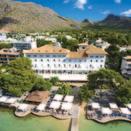
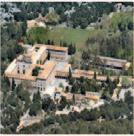
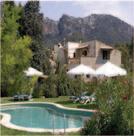
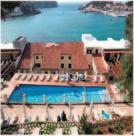

extraordinary mountain bridleway, built in the 1870s by Austrian Archduke Ludwig Salvator, who settled here (7.5 miles, 5 hours﴿. Opportunity to visit Valldemossa, including the Carthusian monastery where Chopin and his lover George Sand famously once over‐wintered, before returning by road to Deià.
Day 8 Transfer to Palma de Mallorca airport (45 mins﴿

u Fine paths through wild mountain terrain


The monastery of Lluc, set in a high sheltered valley of the Tramuntana, originated as an Augustinian hermitage. It was established in 1260 on land owned by the Knights Templar to house a miraculous black Madonna, found at the site by a goatherd around 1247.
By 1456 the hermitage had, under the auspices of Pope Callixtus III, become a collegiate, and by 1531 Pope Clement VII granted Lluc ‘priory’ status. A seminary was added in 1586, followed by accommodation to house the increasing number of pilgrims visiting the site. A boys’ school to
u Long views across the island and sea
u Sea still warm for swimming FEATURES
Moorish, Catalan and Jewish influences combine to produce a distinctive, stylish cuisine based on seafood and fresh vegetables. Highlights are baked sea bass, sausages (botifarrones﴿, ratatouille with potatoes (tumbet﴿, fish casserole (cassola de peix﴿, and ensaimadas, sweet pastries filled with custard or pumpkin jam. The red and rosé wines of Binissalem, Es Raiguer are both respectable while the Pla i Llevant produces a number of smooth whites.
A mixture of well‐made cobbled paths, rocky mountain trails and a few unsurfaced lanes. Lots of ascent and descent, though distances are not that great. Sticks/poles recommended
teach grammar and Christianity was also added and a choir established. Today the choir, known as the ‘Blauets’ in reference to their blue cassocks (‘blau’ means blue in Catalan﴿, comprises 40 boys and girls who sing a mass twice daily.
